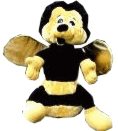Welcome to The Bad Beekeeper's Blog
2008 Blog 2009 Blog 2010 Blog 2011 2012 Blog 2013 Blog 2014 Blog 2015 Blog
 |
Well, it had to happen sometime. For many years, I'd been a great admirer of the beekeeper/writer/specialist Jerry Hayes. He taught a lot of people how to keep bees better. He looked for cures to bee diseases and helped keep everyone's colonies healthier. Some of you know Jerry from his Classroom: Questions and Answers page in American Bee Journal. Month after month, Jerry has answered complicated bee-related queries on everything from splitting strong hives to doubling up weak ones. Apparently, he's moving to the dark side. At least, this is the way some beekeeper-commentators describe Jerry Hayes' moved from Florida's Chief Apiary Inspector to one of Monsanto's newest hires. So, why is Monsanto the "Dark Side" and how did Jerry Hayes become an employee there?
As Florida's chief beekeeper, Jerry Hayes had the job of keeping Florida's bees clean of diseases. Working in the only true subtropical climate in the USA's lower 48 states, the battle against varroa, foulbrood, hive beetles, and (recently) Africanized stock must be overwhelming. Without a cold-season break, these and other pests can breed twelve months a year. Moreover, tens of thousands of bee hives are trucked into Florida by hundreds of beekeepers from dozens of northern states (attracted by the mild winter climate) - increasing the regulatory challenges tremendously. Jerry Hayes has left this thankless job to take a position at Monsanto, which we might guess pays well, too.
What sort of job does Monsanto offer a beekeeper? Monsanto, a large seed development company, bought Beeologics last year. Beeologics was started in 2007 with the mission to provide beekeepers with some tools to fight Colony Collapse Disorder and other bee-related maladies. Jerry Hayes had long been associated with Beeologics, which, according to its website, "...is developing a line of RNAi-based products to specifically address the long-term well-being of honey bees. Also, according to their own website, "The company is recognized by the United States Department of Agriculture (USDA), the USDA-ARS, the media, beekeepers and leading entomologists worldwide." I don't want my cynical slip to show, but I guess that even this blog is "recognized" by those same players - and a few more, too. For Monsanto to be able to meet beekeeper's chemical needs and combat CCD, Monsanto needs beekeepers. And Mr Hayes's Beeologic link and his high-profile made him an inevitable pick.
Why do people work for big companies like Monsanto? I know a chap who worked for four years at a big company - "Mother Satan" as Exxon is sometimes called by employees at the giant oil company. This young man had performed very, very well at university and was about to begin a Ph.D. - but Exxon offered twice the money and free training; a doctorate is expensive and doesn't always lead to a job. Reluctantly, he says, he took the better paying position at Ma Satan - convincing himself that he needed to feed his kids and he had to quit being a student. Most oil company scientists do not start out with the idea of working at in the oil patch. As children, they are usually fascinated with rocks, volcanoes, planets. Oil companies like to hire such bright inquisitive brains and pay them well. Similarly, I knew a lady with a master's degree in entomology. She was a fine hobby-beekeeper, but reluctantly went to work selling insecticides. Not her first choice. She also rationalized - "I can help the company find safer chemicals. Teach farmers to be careful around bees." Maybe it turned out that way for her. I can guarantee you that very, very few employees of places like Exxon and Monsanto want to leave a dirty messy world for their kids to clean up. But, you can be sure that those places also have a handful of idiots employed who want hundred dollar haircuts and thousand horsepower cars and don't care beans about bees. And their bosses want bonuses; their shareholders want profits.
Is Monsanto evil? Is it the dark side? Well, it is a big company with a fiscal responsibility to its owners. Not everyone will like the things it does to make money. To balance its methods, some loud-mouthed, angry left-wing environmentalists would like to shut Monsanto's doors (or at least stone its windows). They have an important role to play. Activist environmentalists try to force companies to be honest. They expose environmental damage; they may keep unbounded greed bounded. On the other hand, those contrarians are from rich clean countries - sometimes they don't seem to realize that the green revolution of fertilizers and genetic manipulations has helped billions of people in Africa and Asia avoid starvation. Somewhere between the extremes of Monsanto and a world without pesticides, GMOs, and manufactured fertilizers, lies a better world. If any huge fault can be found with the Monsanto-types, it is in their patents of genetic modifications - these modifications would eventually arise in nature through evolution. Instead, corporations are allowed to hold patents on living genetic codes. Allowing these patents leads to a lot of corporate power over farmers. It has only been a few years, but there are claims that hundreds of small farmers have been bankrupted by the cost of these seeds and their associated herbicides and pesticides. The poor farmers' lands have been acquired by large (often corporate) farmers. Too often, the lives of the poor farmers have been given up to suicide. Even if the scientific model of smart seeds accelerating evolution is good, the fiscal model is not.
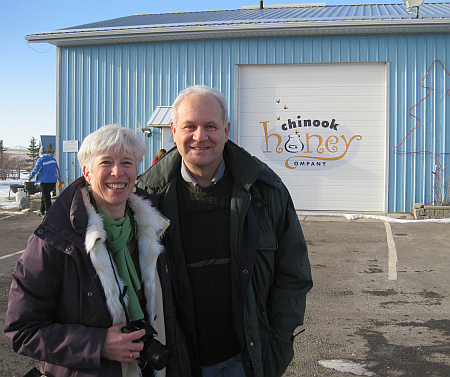 |
We had a great afternoon at Chinook Honey Farm's annual "Christmas at the Hive". We forced two neighbourhood kids to join our own two for a half hour dash out of Calgary to Okotoks, Alberta. Through the town, round some bends, over the hills, then into the farm we slid. We weren't the only ones. There were dozens of people checking out the sleigh ride, the fire pit, the reindeer, the mead, the honey, and of course, the bees. This is the fourth time we have been to Art and Chery's winter carnival. Great fun, as always.
Have you ever made snow candles? Easy. Melt wax, pour into snow, add wick. Well, not entirely easy - safety concerns, of course, loom large when you have a gaggle of youngsters messing around near hot wax. But it turned out well, and the candles were each exquisitely unique. Exquisiteness is dependent on wax temperature. Hotter wax will obviously melt more snow, making a wilder and more distinctive candle design.
With little hands helping, cooler wax is the safer option, but the pattern of melting is more confined to the small hole dug into the snow for the original mould. In either case, don't forget to cut a wick longer than the depth of the mould which you've made because the wax will be melting the snow. Also, if you have just a skiff of snow on the ground, or if the weather is bitterly cold, fill a bucket with snow and bring the bucket indoors where you can work with enough volume and depth and in comfort - especially since you will probably be doing this with kids. It makes no sense for them to suffer nose-frost just because you want to show the little people a good time.
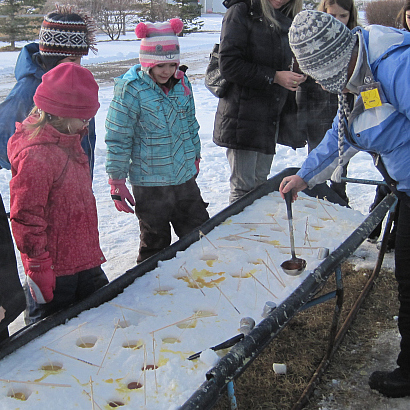 |
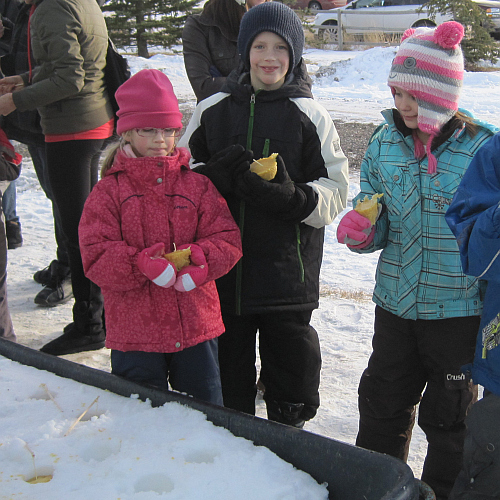 |
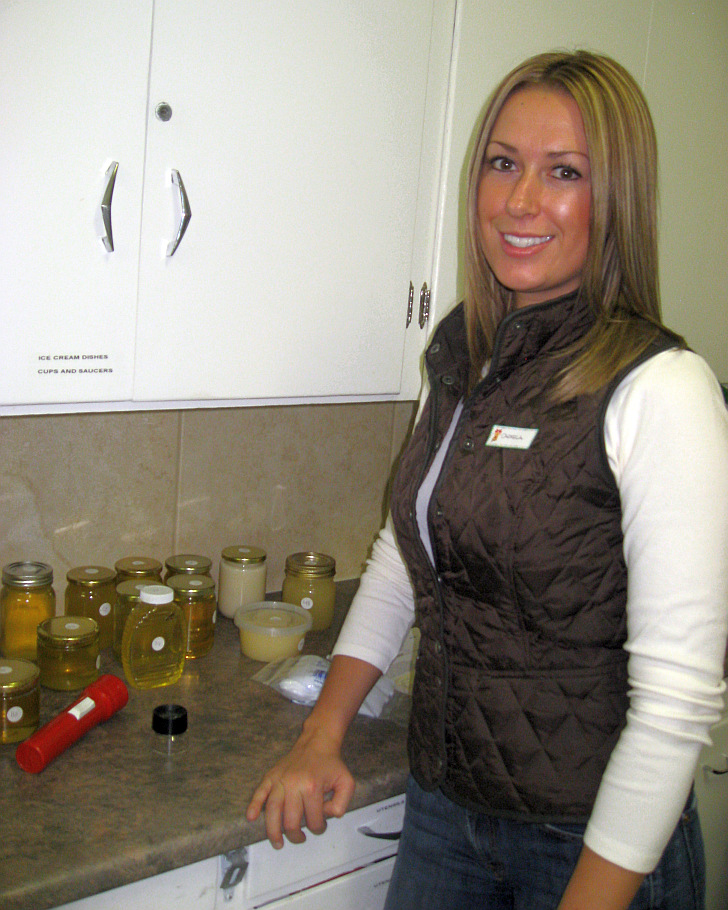 |
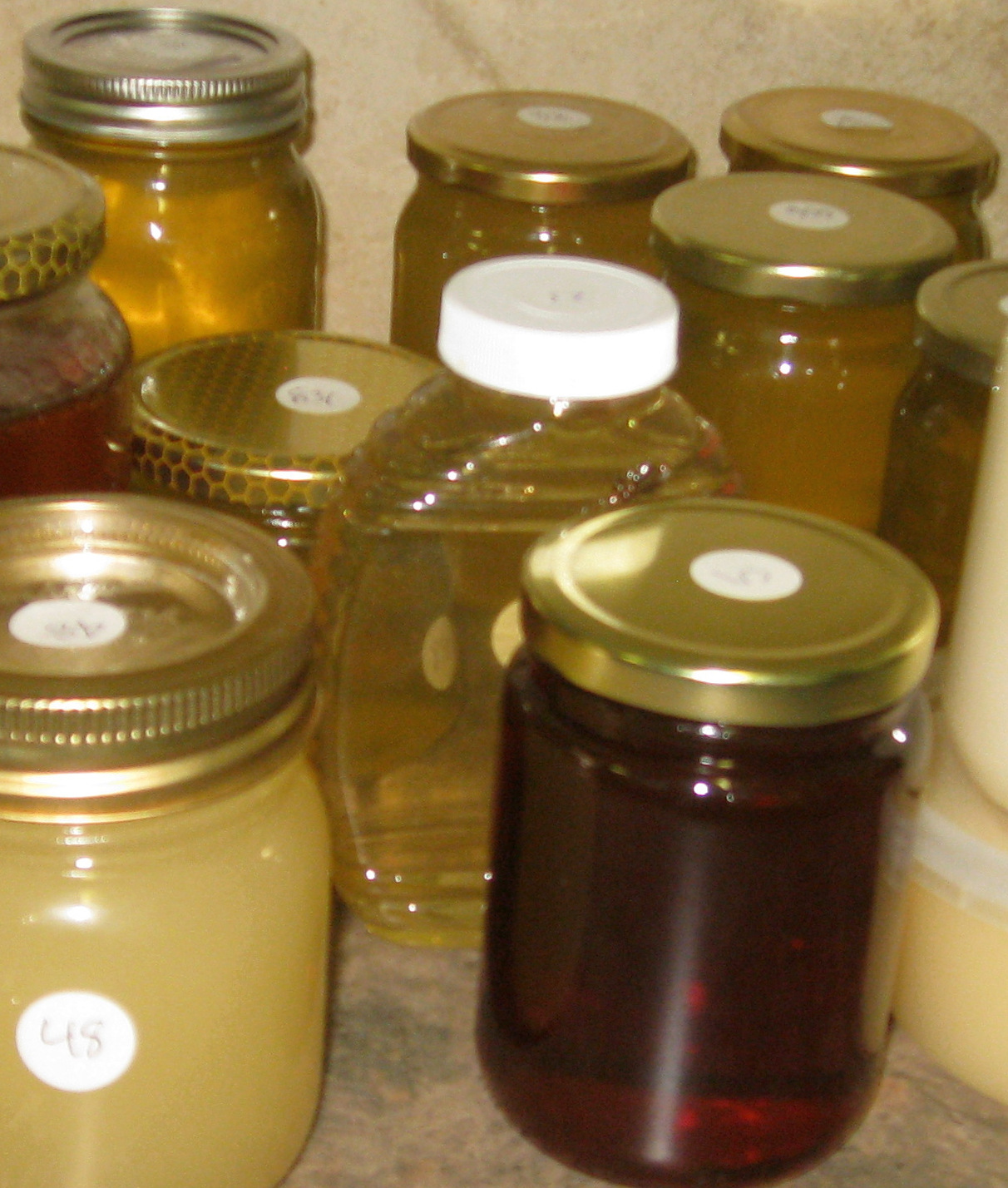 |
I was honey judge at the Calgary Bee Club today. Seventy members were invited to submit their prized possessions for tasting, testing and probing. With the capable help of an assistant trainee-honey-judge named Carmela (whom you see in the photo to your left), the honeys were divided into three classes - light and white honey; dark honey; and, creamed honey. Colour separation for the honey was largely arbitrary - the colour division was based on the most obvious and objective of criteria. (I think it was a good idea for judges, not beekeepers, to classify the honey. I've seen beekeepers unsuccessfully enter bakers' grade black honey in the light categories. Perhaps the judge should always do the grouping.) I had created a scoring sheet, based on Tom Sanford's work (About judging, Sanford has famously said: "The product itself is not examined as much as the care the exhibitor takes in putting it up for show."). I tried to combine his work with the Scottish Bee Association's notes on honey judging and added some personal experiences and observations relevant for our area. You may download my file here, if you want to make copies to use at your own casual honey judging exercise. Our event here in Calgary was entirely for fun - I don't pretend to be a real judge and the entrants don't pretend to be serious beekeepers. Just some fun beekeeping people getting together.
All the honey was tasty - but none of it was awarded points on such a subjective criteria. I like mild, white honey. But many other people - with more interesting mouths than mine - prefer the underbalanced nuances of woody but sprightly bouquets of aromas and sensual flavours carrying perhaps a hint of something similar to merde très savoureux. These arrogant presumptuous honey lovers are describing something that I might kindly regard simply as "flowery" flavoured. Alas, I prefer mild-mannered honey over ill-mannered honey. But as an official judge of the CaABC (Calgary and Area Beekeepers' Club) my reasonable rationality must be leashed; I become an impartial judge. This is why honey judges do not allocate points for anything like a "tastes great" attribute. Flavour is quantified only to the extent that it rules out souring honey and burnt honey. On the lips of a honey judge, all other flavours are equally desirable. I gave ten full marks to all the entries that did not have bottles of over-heated, under-cured honey. By the way, the jars pictured to the left are all from the Calgary area. The really dark honey was not burnt honey, but rather honey from spring wildflowers - including willow, dandelion, choke-cherry, and hawk's beard.
Equally objective honey-judging scores were allocated for qualities such as cleanliness and uniformity of fill. Here it is easier to lose points through sloppiness rather than gain points through diligence. Major honey shows insist on three jars of honey constituting a single entry. The jars are expected to look alike - same vintage glass, same tint of honey, equally filled jars. I once saw a participant loose points because one of the three jars was perhaps a millimetre shy of parity. We get around such tragedies at the Calgary Bee Club Honey Fun Event by allowing just one jar, rather than three, for an entry. (Some of our beekeepers do not produce much more than a single jar per year, so this helps them participate, too.) Rather than compare honey heights, we examined 'accuracy of filling' - are the lids sticking to the honey; or, can one cast an echo into the abyss before honey is hit? Either way results in a few points docked from the score. Along with 'accuracy of filling', we consider cleanliness as a spiritual thing. Honey is often handled bare-handed. It is best that honey handlers are clean-handed as well as bare-handed. And honey starts its life surrounded by bugs, wood, and wax bits. Few of these should be on display in the honey at the judging event.
Among the other interesting and necessary criteria for award-winning honey are the use of nice jars rather than recycled pickle jugs; the display of bright shiny honey (cloudy honey may mean the stuff is heading towards crystallization); and, a complete lack of floating crystals. Honey produced in the southern Alberta foothills usually granulates quickly - it is the nature of the flora here, as well as a result of the cool nights during the summer. So, the beekeeper has a bit of a dilemma. Unheated honey is harder to present clean because thick honey keeps bits of wax suspended. (Alberta honey is low-moisture: some of the judged samples ran down to 13% moisture.) Unheated honey definitely crystallizes more rapidly than honey which has been heated and cooled down. But (here's the dilemma), most people prefer honey which has never been heated. It is whiter and it does not taste caramelized. It has to be done carefully, if at all. Unless you are Lord Baden-Powell, founder of the Boy Scouts. He kept a few hives. Presented some honey at shows. Once, he heated and strained some of his backyard goo but accidentally burned the stuff - it became rather dark. Pressed for time, he entered it anyway. The judges (who are supposed to be impartial) rated the Lord's dark and damaged honey as the best. Maybe it was. Anyway, this started a trend in England for many years where dark, slightly-cooked honey was considered superior.
I wrote about much about honey judging previously on this blog. It is probably worth repeating those earlier suggestions. The scoring sheet I created is available for you to download and adapt to your own needs at this link. Feel free to copy, adapt, and use this sheet. Your local beekeeping organizations may offer official guidelines which you should follow, so check there first.
Please note: Container is judged on suitability of container, container imperfections, and lid/container cleanliness. Density of liquid honey will be judged either by timed bubble test or refractometer. Crystals, foam, air, bubbles, and cleanliness is partly comparison-based. 20 points is usually not awarded. Brightness preferred - as opposed to a dull appearance which might indicate wax or crystalline impurities. Flavour is based on sour odour, fermentation, or caramelization (overheating/burnt flavour) and not on nectar source. Accuracy of filling requires headroom of 1.25 to 2.5 cm (½ to 1 inch). For glass, no visible honey-to-cap gap.KEY CRITERIA for JUDGING HONEY AT A (non-sanctioned) FAIR: 1. CONTAINER - 10 POINTS 2. HONEY DENSITY (VISCOSITY)– 15 POINTS 3. FREEDOM FROM CRYSTALS – 15 POINTS 4. CLEANLINESS AND FREEDOM FROM FOAM OR AIR BUBBLES – 20 POINTS 5. BRIGHTNESS – 10 POINTS 6. FLAVOUR/AROMA – 20 POINTS 7. ACCURACY OF FILLING – 10 POINTS
Here are some extra resources you may want to consult: West Virginia's Honey Show Rules; Maryland State Beekeepers' Honey Judging Standards; the Scottish Beekeepers' Association Guidelines for Honey Judges and Show Committees. And just for fun, if you want to read something really different - Jennifer Weedman used the honey judging criteria to throw some sticky stuff at politicians - you can read her paper here.
The Tea Party has won another one. In the name of fiscal prudence (and due to much prodding and poking by fiscal ultra-conservatives), the American federal government has closed down its bee counting operation. The government's own website justifies the elimination of the Annual Bee and Honey Report as a result of fiscal constraints. Likewise, sheep, goats, veggies, mink, potatoes and a whole bunch of other stuff - as you'll see listed on the USDA site. The statistics for honeybees (and other agricultural products) have been collected for a hundred years. Analyzed by scientists, historians, and social planners.But also used to justify research and payment support programs for farmers - expensive things that people who drink tea can apparently do without... I hope they enjoy their sour drink, sans the bees' sweet stuff. Meanwhile, up here in in the cold socialist north, StatsCanada is offering statistics for free. In both official languages.
 |
It was Windsday all day. Some Alberta beekeepers spent the day in Saskatchewan, retrieving bee wraps, boxes, hive tools, and trucks that were either stolen by our poor cousins to the east or were blown across the border by the hurricane-force winds that beat up Calgary and all parts of southern Alberta. Winds were measured at 148 kilometres per hour (that's about 90 miles per hour for the metrically-disadvantaged). The downtown of Calgary was closed (by emergency workers) for the day because winds had extracted huge windows from skyscrapers - shattering them on the streets below. Beehives - out on the even more windy prairies - also had trouble keeping their windows in place. Most hives on the Canadian western plains are wrapped with insulation for the winter. Some of that material became untangled and set free in these winds. Luckily, it was not extremely cold and hives did not generally topple over. However, beekeepers have been scurrying around their apiaries, re-wrapping their bee boxes.
The picture to your right is from Cherie and Art Andrews' Chinook Honey. Cherie told me that only this one hive was messed up and the bees inside are fine. Chinook Honey's farm and meadery is located a few minutes south of Calgary, near Okotoks. The place has a gorgeous honey store and gift shop - a major tourist draw in Alberta. Each December, Chinook Honey celebrates "Christmas at the Hive" - an open-house event with honey, mead, wax, demonstrations, and reindeer. Fun for everyone. Over 18s get to tour and taste from the honey-wine workshop, too. This year's celebrations will be held on consecutive Saturdays - December 3rd and December 10th. For more information, check out their web site.
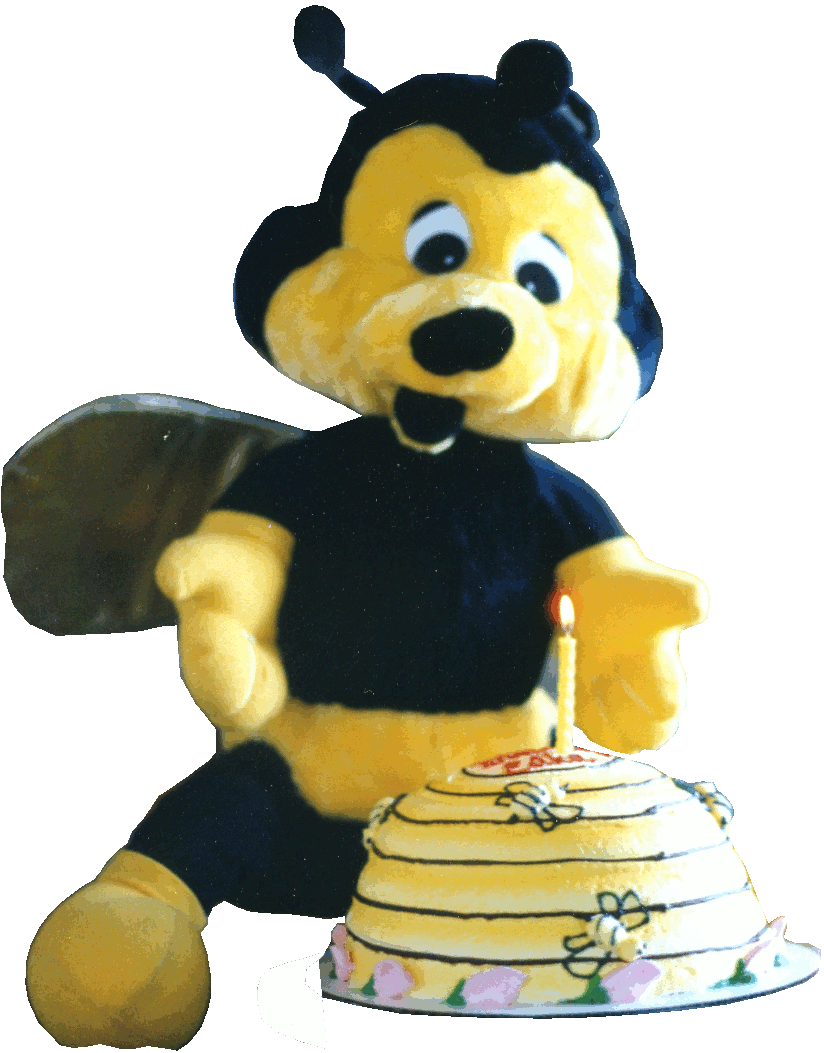 |
My main website - www.badbeekeeping.com - has been around since October 7, 1995. It is probably the oldest beekeeping website in the world. I started out on now-defunct Compuserve with a long cumbersome url, but the site is still essentially the same "Beekeepers' Home Pages" and some of the original graphics are still in use. Seventeen years is pretty ancient in website terms.
I've had thousands of e-mails over those years. And some of the correspondence resulted in friendships with some interesting folks. But there were so many e-mails that I ended up hiding my mailing address deep within the dozens of web pages in order to slow down the number of letters targeting my Inbox. I've once again made my address more accessible - use this link to write to me, but only if you are as needy as a hungry bee. I occasionally write back.
The Bad Beekeeping site has been fun to write and has been a way to express some of my enlightened notions and opinions about bees, beekeeping, and society in general. Way back in the 90's I was writing a sort of ranting 'news and views' column that was as irreverent and irrelevant as this blog is today. You can still find the remnants of some of that if very old drivel if you dig around on the site a bit.
This afternoon, at 1:30 Calgary time, the old Beekeepers' Home Pages at www.badbeekeeping.com had its one millionth visitor. That's not as huge a number as you might think. It means that after a bit over 17 years (6250 days), we have had an average of 160 daily visitors. In the beginning, about 20 people a day dropped by to see the site. By around 2000, the number was up to 400 visitors each day. Lately, numbers are off a bit - mostly because there are so many other really great beekeepers' websites in the world now. Over the years, I have tried to catalog some of the best - you may have seen them posted on One Thousand Great Places to Bee on the Web which only lists sites I have actually visited and enjoyed.
 |
How was the crop in Alberta? According to Lee Townsend, a Canadian Honey Council Rep from Stony Plain, Alberta, "Overall, honey production was below average... If you talk to ten different producers in Alberta, you'll get ten different answers - but does appear to be a combination of weather and smaller colonies due to aggressive splitting... It also doesn't help that the primary flow arrived three weeks late."
Our own results reflect Townsend's description. We had a 'below average' crop. But it wasn't terrible. The flow started late, giving splits a chance to grow and splitees a chance to recover. We had some honey. Rather pleasantly, sales of comb honey have escalated. It seems the stuff is now more popular than it has ever been.
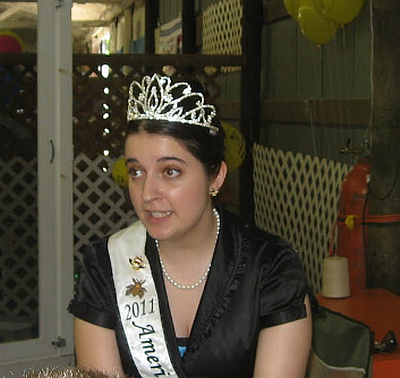 |
I noticed a notice about a nice girl getting noticed in Wisconsin. Here is a link to the page about the American Honey Queen visiting schools in Wisconsin Rapids, Stevens Point, Plover, Junction City, Plainfield, Nekoosa, and Vesper - and talking about bees and beekeeping.
The Honey Queen is Teresa Bryson of Chambersburg, Pennsylvania. She has been a real live beekeeper herself for the past few years. And she's a keen student (Dean's List) at school. Ms Bryson is an English major at college, so naturally I'm hoping she doesn't read this website. But, T.S., if you do, please e-mail your grammar corrections and suggestions so I can make this site better than it was yesterday.
Normally, I'd have mixed feelings about the role of Honey Queens. (Why isn't there a Honey King, eh?) But this sounds like an ultra-nice young lady who is working very hard to promote a good cause. She is in Wisconsin for the annual Wisconsin Honey Producers meet-up and is using lots of her free time to talk bees. Teresa has also worked on promotions is Montana, Oregon, Ohio, and (of course) Pennsylvania. Wish we had more people like this in the world.
Have you ever seen the International Space Station passing overhead? It is amazing. This evening, a few minutes after the sun had set, my kids and I went into the field behind our house. We relaxed on the grass in the cool autumn evening as the flying bus passed 400 kilometres above us. We could see the craft for about three minutes - a determined streak of reflected sunlight which marked the position of the Icarusian voyageurs - a Japanese surgeon, an engineer from South Dakota, and a second-generation Russian cosmonaut. We waved a proud salute to those twilight fireflies. I wonder how the Space Station's honey crop was this year.
A lot of American honey bees are heading to warmer places this month. Occasionally, the trucks carrying those bees end up rolling into a ditch. Fortunately, in the latest case, the driver (and his wife) are OK. But one telling of this story is a bit weirdly written. The title "Truck Tips, Freeing 25 Million Bees" is odd, to say the least. --- "Freeing" 25 Million Bees? Would you call it freeing if someone's house burned down? "House Catches Fire, Freeing the Homeowner and His Family"... The story continues saying that the "Bees went berserk and swarmed the trucker and his wife" --- Bees went berserk? "Man, freed from his burning house, spits at ground and curses" would be the corollary. Well, perusing the story for its content (rather than its rather poor style) one learns that the 25 million bees are a very small part of Richard Adee's 4 billion bees - sent in 160 semi-truck loads from America's mid-west to Bakersfield, California. "It's pretty much a complete loss," Adee said to the Associated Press of the $116,000 load. Let's see... 160 truck loads at $116,000 each - that's about twenty million dollars worth of bees and equipment that this one beekeeper is sending down to California's almond groves. Four billion souls. Seems like a lot of bees for one outfit to command.
"Is honey manufactured bee barf?" I got this question from a reader who referred me to a Vegan website. I doubt you are going to jump to that link, so I'll tell you what you would find, if you were to go there.
"In regard to honey, over 50% of the total North American crop is NOT bees producing honey
from nectar and pollen, but is force fed cheap crystallized high fructose corn syrup to the
bees, who enzymatically flavor it and then barf-it up again to be labeled as 'honey'. This
is why most honey crystallizes, the high level of refined corn high fructose in it, which
is medically proven to metabolize in the body automatically as adipose tissue (body fat)
and triglycerides, leading to obsity [sic] and heart disease, if the allergenics
doesn't get you first."
My reader - the one who sent me the question ("Is honey manufactured bee barf?") was wondering how much truth was in this Vegsource.com page. Well, not much. Which is shameful, really. Vegans - or at least. their more benign cousins, the vegetarians - have a lot of valid points to make. Points that don't need exaggerated by mis-information. We are healthier eating veggies instead of meaties. The planet is healthier, too. If you can read through the poor grammar and misspellings on that Vegan website, you might surmise that the food-expert/nutritionist who threw this drivel up on the internet is hiding some information among illiteracy. Unfortunately, you would be mistaken. Let us dissect the slander.
 |
First, this page of the Vegsource site declares, over 50% of the total North American crop is...force fed cheap crystallized high fructose corn syrup. Not true. Some beekeepers feed sugars to bees when those bees might otherwise die of starvation. This might happen when bees are facing a long cold winter (no flowering nectar for months) or if the bees have been going through a patch of drought that has desiccated fragile blossoms. So, in desperation, beekeepers may feed bees. Typically, the bees are fed either honey or table sugar. Occasionally - rarely - corn syrup. The statement that over 50% of the honey crop is force-fed corn syrup becomes total nonsense when you learn that almost half the honey in North America comes from Canada - where corn syrup is not fed to bees! Almost no bees - anywhere in North America - are fed corn syrup, and bees are fed to keep them alive and healthy - not as a way to convert sugars into honey. (Which, by the way, wouldn't even work.)
These stupid comments on the website Vegsource.com loose further credibility when you realize that bees can't eat crystallized corn syrup. In those few places in the world where corn syrup might be fed to bees to keep them alive, it has to be liquid - not "crystallized". The website goes on to say that if honey you buy in a store is crystallized, it is because of corn syrup. Again, not true. In fact, pure, natural, unheated and unfiltered honey normally crystallizes. So, if you find crystallized (granulated) honey, you are most likely getting unprocessed honey. The real deal.
These sorts of website pages, as I've said, are a sad bit of misinformation which seriously damages the credibility of vegetarians. They should be shut down - by the vegans themselves, unless they thrive on looking uninformed, unscientific, or just plain stupid. But, sadly, such websites seem to live forever. Fifteen years ago, another vegan site stole a number of photographs from my internet pages and pasted them onto their own site - as examples of how beekeepers mistreat bees. Honey bees were described as "enslaved" labourers "forced to gather honey for greedy masters". My pictures - bees flying out of homemade boxes - contradicted this, of course. Bees are free. They don't have to come back to the beekeepers' hives each evening. But, they do - because they like the warm, comfy abode. In the symbiotic bee-beekeeper relationship, bees are kept alive by beekeepers who are kept alive by bees, who are kept alive by beekeepers, who... well, you get the picture.
If you are wondering about other parts of the quote above, let me quickly say that bees do not 'enzymatically flavor corn syrup and then barf it up' - bees don't barf-up anything. Not even nectar, which they carry home from flowers in a special nectar-carrying sack. I guess you could say that your favourite waitress barfs-up beer from a pitcher when she fills your mug. No, honey is not barfed-up anything. Nor is it adulterated by corn syrup. The Feds (FDA in the USA; CFIA in Canada) take samples and can find a few parts per billion of corn-based sugars. And they take infractions - adulteration - seriously.
I'd like to add that some of my best friends are veganistic. Before you feel compelled to leave a cabbage head in my bed try to remember that I am largely on your side. Better nutrition usually starts with a green-based diet. The products of the bees are natural foods gathered directly from plants. And beekeepers love their honey bees. We don't kill them, enslave them, or make them sit in the rain on cold days. The honey that is taken is excess that would force the bees to become so congested their hive would likely die (as often happens in nature). Honey is not taken from hives that need all they have produced. That's just not right.
One last thing. The page I mentioned above is just one of dozens of pages attached to vegsource.com. I poked around the site a bit and realize that this page is not necessarily the website's official opinion. Nevertheless, the page has existed with this mis-information since 1998!! That's a lot of time to be telling something grossly untrue without someone taking the page down. Scouting around, I found what appears to be Vegsource's official position on honey. Here is some of what is said there: "honey (which is essentially bee vomit)...is considered an animal product. Because there are numerous alternatives to honey, from a vegan perspective there is no justifiable rationale for using it. Furthermore, the vegan position on honey is definitive. Honey was prohibited for use by vegans according to the 1944 manifesto of the British Vegan Society (veganism's founding organization)..." I don't know about you, but I find it kind of cool that back in 1944 a "manifesto" was promulgated that Vegans accept as some sort of gospel today. Kind of like the Emperor Diocletian ordering all offending versions of the Bible destroyed by fire in 302. Now, after all those years, you can't go against canonized truth. Sort of like the "vegan position on honey" being definitive. Because some modern Council of Veganism said so, seventy years ago.
 |
The November issue of Canadian Living Magazine hit the shelves October 13th!! Of course this is really big news - the national magazine ran a piece on our own honey farm - Summit Gardens Honey Farms. The purpose of the magazine's article was to feature great Alberta foods and honey comb, of course, had to be included.
The authors of Canadian Living tell us: "Cross Canada Cooks: Alberta - Celebrating the vibrant food, recipes and culture of Alberta" which is a tall order as so much good eats comes from our province. As the story reports, "Talk about Alberta's liquid gold and people will assume you're talking about oil. But if they spent some time strolling through farmer's markets or eating at the growing number of small, local restaurants around Alberta, they'd see that the conversation could just as easily be about honey." And that is fairly true. Almost everyone I know out here in Alberta talks about bees and honey. And nothing else. It is undoubtedly the very best honey produced in the world. Canadian Living Magazine especially wanted to talk about our farm's product - natural, raw honey comb - unprocessed and virtually untouched by humans. The bees make the honeycomb right in the container in which it is sold. "We just put a lid and a label on it and it's ready to go," they quote me saying.
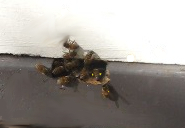 |
Pollen still coming in from the flowers! Of course, we've had lots of frost already. I am always surprised that honey bees can find late-season pollen. Not much. Not very large wads. But, yellow pollen from.... something. Something yellow, probably. What could it be? I looked up late-blooming prairie flowers in Frank Pellett's American Honey Plants and John Lovell's Honey Plants of North America, looking for some clues.
For the Great Western Plains, both books mention goldenrod and aster as late-season honey and pollen sources. Goldenrod prefers acidic soil - but Alberta's dirt is as alkaline as lime. Asters are rare around here, too, but not non-existent. If you have any ideas of where these little blobs of pale-yellow protein are sourced, send me a note, please.
I counted (filmed, actually) eight pollen bees in 70 seconds. The amount was small. But still important. Any protein this time of year is good for the bees' chances of surviving the winter ahead.
Happy New Year! The JCC near our house had a huge sign: "May You Have a Sweet New Year." Traditionally welcomed with honey and apples. Hope you had a sweet welcome to 5772.
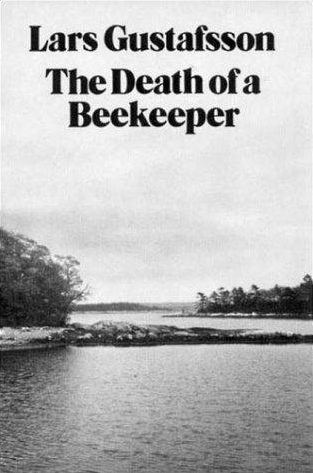 |
The Death of a Beekeeper. No, not me - I'm still alive. But I just finished reading a book with that title. The Death of a Beekeeper Written in Swedish, by Lars Gustafsson. Apparently, Gustafsson is a major writer in his cold, egalitarian homeland where his works are celebrated for their obtuse literary quarks. And although the story is moderately interesting with a slightly seductive character development, unfortunately this small book left me a bit empty. It is presented as a series of entries in various journals - brief notes from the dying protagonist.
Notebook entries presented as storyline are an unusual way to present a novel. But, it is not enough of a tale of death to warrant keen concern for the dying beekeeper. To deserve such concern, one would like to see the beekeeper have a desire to live. Although the author repeats a mantra ("We never give up. We begin anew.") it feels the beekeeper has never even started to live. His self-interest is so lacking, that the reader can't get emotionally involved in this brief story. And, if you are a beekeeper-reader yourself, you might wonder where the bees are... barely mentioned. They might have been a significant counterpoint to what should have been a powerful story. Instead, considerably more ink is spent describing the anti-hero's years as a grammar-school teacher. The book might as effectively been called "Death of a Second-Grade Teacher" - but then, I would not have read it. OK, I'm being harsh. The author - a philosophy professor and prolific writer - is well-respected and "Death of a Beekeeper" is considered Lars Gustafsson's most acclaimed achievement. So, maybe you will like it.
I'll admit that don't have much time to read novels. After perusing various industry journals, my usual reading fare is The Economist
magazine. It arrives on Tuesdays at my house here in Calgary. By the time I finish the magazine's hundred or so pages, it is Monday evening and the next installment of world events is imminent. So, I haven't much time to read other material. But Economist magazine is surely the best source I've seen for unbiased news. I don't always agree with its opinions, however paper makes me think. The focus and attraction is economics-driven, but science, technology, and politics are all well-represented. About twice a year, the Economist publishes an article with a focus on some aspect of bees or beekeeping. Economist is the only popular magazine I've ever seen that rarely gets a fact or detail wrong. Sometimes conclusions and editorial points are a bit baffling, but statements of fact are almost always accurate. This is such a relief compared to other sources that often describe wasps as bees and worker bees as males and honey as bee-droppings. Some recent bee articles in the Economist include Bee Biology: Epigenetic Anointment and Agriculture: The Bees are Back in Town.
 |
The European Union has ruled against honey from Canada, the USA, and most other parts of the world. There was not a direct rejection of bringing these honeys into Europe, but rather a ruling on the status of honey which may contain genetically modified pollens. I'll describe the case in a moment. Let's be clear - genetic modification is plant and animal breeding sped up (by a factor of several thousand). Humans have been slowly manipulating the earth's gene pool for thousands of years. Before you abuse me with unthoughtful letters, please remember that I am strongly in favour of constant, independent monitoring and regulation of this business. Which will be more strict than it was in the days when humans turned grass into wheat and wolves into poodles.
The court ruled that a disclosure and regulation obligation exists "irrespective of the proportion of genetically modified material contained in the product". This means there must be new product labels and perhaps the banning of imported foods of all sorts. With detection of parts per trillion, it is unlikely that any food can be gmo-free. So the ruling "irrespective of the proportion" means that all food sold in the E.U. must have 'gmo-alerts' included on the labels. Interestingly, the culprit - modified bore-worm resistant corn - was approved for human consumption in Europe way back in 1998! So people have been consuming the corn (and its pollen) for almost fifteen years. Commentators quoted in The Guardian say that because the maize has already been cleared for human consumption, it seems perverse to outlaw honey that happens to be adulterated with tiny amounts. And don't forget, corn is wind-pollinated, so the chances of bees gathering corn pollen (the hives were 500 metres away) are vanishingly trivial. The chances of bees being killed by pesticides used to attack the corn worms are much higher. I'm not saying Monsanto was doing the consumer a selfless act of kindness - but I'd rather eat a miniscule amount of slightly modified corn pollen already deemed safe than eat pesticides in my food or see bees killed by pesticides.
All of this is because a tiny group of Bavarian beekeepers had launched a lawsuit against a German government jurisdiction because it had allowed Monsanto to trial some genetically modified maize (corn). Pollen from that field crop test somehow ended up in some local beekeeper's honey. I wonder if the honey was from the very popular acacia - black locust which is non-native to Europe (it was introduced from North America) but which makes most of the best honey in Bavaria. I wonder if the bees producing that tainted honey were Italian bees? Caucasian? Both non-native races. I wonder if the man-made beehives contain wires, nails, and other alloys? I wonder if the beekeeper drove to the apiary in a gas-fired horseless wagon? I guess you can tell I am irritated. So many of us want to halt science and society to something that existed just after we got what we want - but before the rest of the world gets what it needs. I am not in favour of the indiscriminate, unregulated release of FrankenCreatures into the environment. I don't love the huge multinational corps which take gigantic government grants but then prosecute farmers who use what those companies claim are "their" patents/copyrights/intellectual properties. Any entity which takes money from the government (or uses public resources) has to share the results. It should be inherent in the receipt of the people's money. In my mind, the real problem with genetic modification occurs when third world countries depend heavily on developed countries where corporations hold patents for food. And, of course, farmers (even in rich countries) are not allowed to keep the seeds of their crops to use for the next year, but have to purchase the seeds over and over again. These are the real crimes of genetic modification - developers were successful due to monetary grants, trade-offs with universities, and other public gifts, but then hide behind 'intellectual property rights' claims. Shameful corporate welfare.
Humans have been genetically modifying their food for ten thousand years. The resistance against this reminds me of stories from 19th century England - humans were supposedly not designed to travel faster than they can walk, so trains were to be banned lest passenger disintegrate. Later, campaigns were launched to ban electricity in houses as it would surely disrupt the thought process. I am not in favour of unregulated scientific experimentation. But, I am in favour of the progress science has brought to humans. Birthrate is falling, people are healthier and living longer. The environment is cleaning up in most parts of the developed world. Meanwhile, genetic improvement of foods has already saved millions of lives and increased health around the world. It has removed billions of kilos of toxic chemicals from farmlands. To deny the benefits of genetic modifications and to attempt to halt progress in this field requires a reversion to heavy use of pesticides and herbicides and it also means an abandonment of (for example) the Swiss-developed golden rice - the type which includes vitamin A (beta-carotene) and can help prevent blindness in millions of poor children. Or maybe we shouldn't care about millions of poor children, as long as we don't have to be frightened by things we don't want to understand?
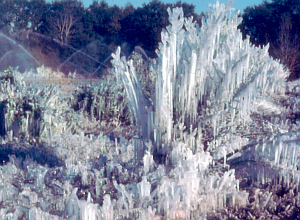 |
Frost in Calgary. It was a slight frost - most evidence was painted on neighbouring rooftops - but a definite clearing and chilling. By about five this morning, icy glitter was shimmering off car lids and roofing shingles. It probably means the end of the nectar which was flowing each nice day since mid-July. Even if this light frost doesn't completely kill the flowers out at the farm - which is at a lower, warmer elevation than our Calgary house - this sort of weather helps the beekeeper make the decision to switch to autumn mode.
Last honey supers should be quickly dragged home and fall chores should be started. The long-range forecast is for really nice warm dry conditions for a couple of weeks. If true, that will help the bees consolidate for winter and will help the beekeepers get their work done. Last September was wet here - trucks were getting stuck. It doesn't look so gummy this year.
A few days ago I mentioned that Saskatchewan beekeepers are receiving $370,000 in Canadian federal money to study the loss of honey bees in that province. A similar announcement was made by Prince Edward Island's Minister of Agriculture for a "Honey Bee Development Initiative" to try to generally help PEI beekeepers. This money - $100,000 - seems ear-marked more towards beekeeping development than CCD, according to the CBC News story. Rather than adding to the plethora of Colony Collapse Disorder studies already undertaken around the world, the cash seems destined to build a more robust bee industry - which is currently engaged in pollinating an annual million dollar blueberry crop.
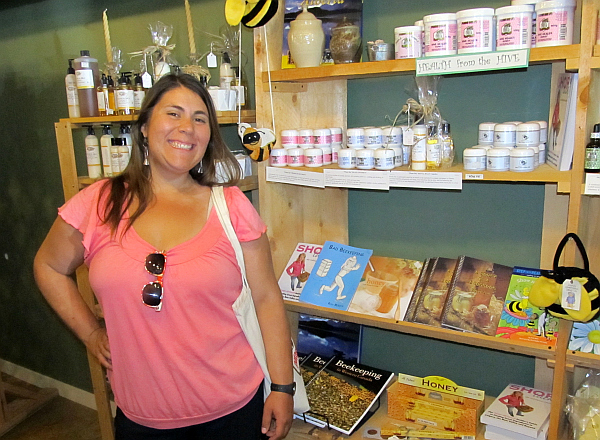 |
We have a friend visiting us this week. Alejandra is the daughter of the well-known Chilean beekeeper, Francisco Rey. Alejandra has been in Alberta for a few months and is spending this week getting a close-up look at Calgary. Alejandra is very much engaged in her father's queen-breeding and avocado-pollinating business, helping with those thousands of hives. She regularly works in the field making nucs, grafting queen cells, preparing hives. Her intention is to continue in the family business.
Today we ventured thirty kilometres south of Calgary to Art and Cherie's Chinook Honey Company near Okotoks, Alberta. Chinook Honey is a busy honey farm with hundreds of producing hives and with several beekeepers on staff. But it is also quite a nice tour-stop with a meadery (honey-wine-making shop) and a very extensive honey-products store. The wine-making is mostly Art's domain and he has learned to brew up some wonderful (and award-winning) vintages. I especially enjoy his rather mild Melissa's, but Art's King Arthur label is among his other great ones, too.
This weekend, Chinook Honey is hosting its 6th Annual Harvest Festival with a professional chef presenting a cooking demonstration. No prizes for guessing what one of the key ingredients in the food might be!
 |
Saskatchewan beekeepers are receiving $370,000.00 from Ottawa. The money is to help find reasons why some Saskatchewan beekeepers lost 80% of their colonies since a year ago. In a CBC News story, Barry Brown (President of the Sask Bee Commission) says this is his worst year ever for losses - and he has been beekeeping for about 40 years. That makes the situation worse than when tracheal mites arrived. And worse than when varroa was accidentally introduced into Saskatchewan. Maybe this extra money can help scientists finally figure out colony collapse disorder. So far in North America, several million dollars have gone into CCD research - with no definitive explanation for this problem. But hopefully, the riddle will be solved in Saskatchewan with this $370k... Kelly Block, Conservative Party MP for Saskatoon-Rosetown-Biggar, announced the Agriculture and Agri-Food Canada cash grant. Canada has a huge public debt - now over 566 billion dollars - the highest ever in Canadian history. But, of course, we are tickled silly that this is money for beekeepers! Thank you Kelly Block!
It will be great to see the research that comes out of this investment. The USDA - after bringing together 80 entomologists from around the world - released a CCD Action Plan in 2007... but no solution to CCD. At the University of Arizona, microbial causes for CCD have been studied; at the University of Nebraska, something called transcript abundance is implicated in CCD; the esteemed Science featured an article linking an imported Australian virus to CCD; the USA's Environmental Protection Agency (EPA) has been studying potential links between pesticides and CCD; while the Journal of Apicultural Research has this paper on CCD research which was a joint effort by research scientists in South Africa, Wales, England, and Switzerland. If you go to a link from Google Scholar Research you will find 16,900 more links to hundreds of papers by scientists who have studied CCD - many proposing conflicting theses. But spending this fresh federal money on new research conducted in Saskatchewan might focus these different views and at last resolve the mystery. I will post their results here in this blog - hopefully within the next couple of months.
The CBC news article goes on to say that around the world, the bee population has been reduced by sixty percent. This would be frightening - if it were true. Actually, others claim that the world bee count has increased around the world in the decade since Colony Collapse Disorder has first been observed. Here is another recent story - also from CBC News - which is titled "Honeybee colonies not declining worldwide" in which the authors - Canadian Dr Harder and Argentinian Dr Aizen - demonstrate that the worldwide colony count of honey bees actually increased 45% in past years. Vietnam, Brazil, Kenya, India, and many other countries, now have millions more colonies than in the past. Decreased 60%? Or increased 45%? Mixed signals, indeed!
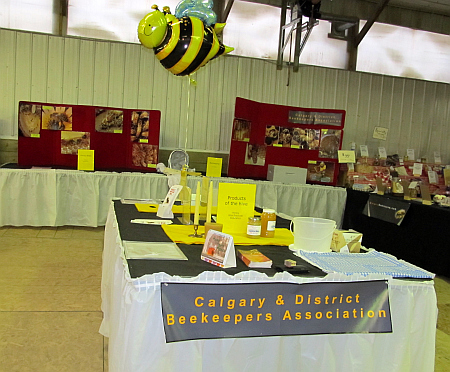 |
This huge beekeeping display was set up by the Calgary and District Beekeepers Association at this weekend's Millarvile and Priddis Fair. This is a big effort and a nice achievement for this group of beekeepers. These folks have done a lot to make the public aware of beekeeping and its importance for the farm community in Alberta. I watched the Calgary beekeepers (some of whom had traveled an hour to be here) as they set up the rather extensive display of beekeeping tools, posters, observation hive, and equipment. Nice work.
I was president of the Calgary Beekeepers for quite a few years back around the end of the last millennium. I didn't do half the job that this new group has done. I was mostly content to try to design a bee discussion meeting every couple of months. The new group is a really hard-working bunch of beekeeping enthusiasts who have achieved the club's mandate to "to promote and encourage good beekeeping practices" and to engage the general public.
If you'd like to see an example of a well-designed web site for bee clubs, the Calgary Beekeepers site shows you what can be done. Plenty of community engagement here. There are. of course, pages of up-coming events and announcements. But also public information on swarms and and sources of information for new beekeepers trying to get started in the art. Of course, there is really no better way to start beekeeping than to join up with a local bee club and to engage the aid of an experienced beekeeping mentor! If you are in southern Alberta, the next beekeepers' meeting will be Wednesday, September 14, at the Banff Trail Community Centre.
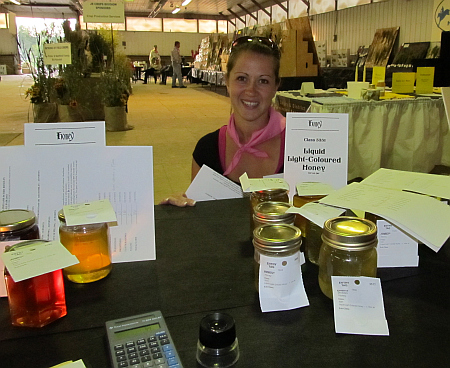 |
I was invited to judge honey at the Priddis and Millarville Fair. The 104-year-old fair is located 40 kilometres south of Calgary at the Millarville Farmers' Market and Race Track Grounds. The fair has only recently added honey to its ribbons program. So, this year's entries were a bit sparse - just 3 classes (light, dark, creamed) and 19 items. (I suspect there will be more candidates next year.) I was called only a few days before the fair date, and given the time and location (and even an assistant!). I had enough notice to pull together some ideas from a variety of resources. I've judged honey before, so I created a 100-Point Score Sheet with a few adaptations for our local environment.
When judging honey, keeping score with points helps add as much objectivity as possible. Personal preferences (some people like strong, dark honey; others light and mild) have to be monitored and avoided. Of course, if you prefer sparkling clean honey that does not taste burnt, that is actually worth some points. The scoring sheet I created is available for you to download and adapt to your own needs at this link. Feel free to copy, adapt, and use this sheet. Your local beekeeping organizations may offer official guidelines which you should follow, so check there first.
KEY CRITERIA for JUDGING HONEY AT A (non-sanctioned) FAIR: 1. CONTAINER - 10 POINTS 2. HONEY DENSITY (VISCOSITY)– 15 POINTS 3. FREEDOM FROM CRYSTALS – 15 POINTS 4. CLEANLINESS AND FREEDOM FROM FOAM OR AIR BUBBLES – 20 POINTS 5. BRIGHTNESS – 10 POINTS 6. FLAVOUR/AROMA – 20 POINTS 7. ACCURACY OF FILLING – 10 POINTS Please note: Container is judged on suitability of container, container imperfections, and lid/container cleanliness. Density of liquid honey will be judged either by timed bubble test or refractometer. Crystals, foam, air, bubbles, and cleanliness is partly comparison-based. 20 points is usually not awarded. Brightness preferred - as opposed to a dull appearance which might indicate wax or crystalline impurities. Flavour is based on sour odour, fermentation, or caramelization (overheating/burnt flavour) and not on nectar source. Accuracy of filling requires headroom of 1.25 to 2.5 cm (½ to 1 inch). For glass, no visible honey-to-cap gap.
Here are some extra resources you may want to consult: West Virginia's Honey Show Rules; Maryland State Beekeepers' Honey Judging Standards; the Scottish Beekeepers' Association Guidelines for Honey Judges and Show Committees.
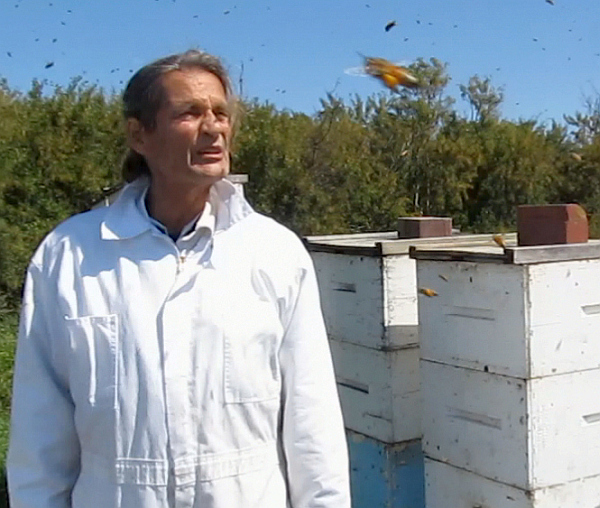 |
Pretty cool picture, eh? Our friend Jacques was checking the pollen baskets of bees arriving at our hives today. I was surprised at the large amount of pollen because these colonies were pretty crowded with honey - jammed-up boxes usually don't have much pearl brood and have even fewer places to park such copious volumes of incoming pollen packs.
It is always a struggle for the beekeeper to balance the amount of space in a hive. Put too many boxes on too early and the bees are demoralized and the queen rushes up to the top of the hive and lays eggs in the honey supers. With excluders, the queen stays down - but so does the honey. But if the boxes are still in the shop when the flow starts, the bees are unlikely to fly to your warehouse to deposit their nectar. Even with boxes on at the right time, you can't predict the weather so honey supers may still sit idle or may be packed with honey in a week. The beekeeper has to monitor everything - yet not bug the bees by constantly monitoring everything. It is a tough thing for new beekeepers to learn to balance. It takes years of experience to really learn this.
Sometimes beekeepers send me e-mail asking when to put their supers on their bees. I appreciate it when new beekeepers realize they need advice, but sometimes these notes come from places a long way from my back yard. They might as well ask me, "In the next month, when should I mow my grass?" To answer that, I'd need to know what kind of grass they are growing, what the soil is like, what the seasons usually have done in the past, and I'd have to be able to predict the next month's weather.
Nothing can take the place of experience. However, a smart new beekeeper who is flexible and willing to work hard can usually stumble to the finish line the first few years with a bit of honey. But one more thing - much depends on the season. If you have a bad honey season, it might not be your fault. And if you have a huge bumper crop, it might not be because of your outstanding skills, either.
A big smash-up, according to the CBC news story "Swarming bees close Alberta highway". Bees and boxes were scattered across a rural road, right here in Alberta. Not many truck wrecks involving bees up here - we don't have much in the way of migratory beekeeping going on. I don't know any details on this story, except the very sketchy tale told by the news - which says, "...the swarming bees made the cleanup all but impossible." I wonder if the reporter has ever helped harvest honey. I can see the leading sentence: "Swarming bees are making this year's honey harvest all but impossible."
Of course, it was not impossible to clean up the bees after the flatbed hauling them rolled. The 104 hives (26 pallets) that littered the road southeast of Edmonton were scooped into the broken equipment and hauled away on two trucks. This news story misses the bigger story. Why were these hives being moved mid-summer in central Alberta? I don't know, but my guess is that they were part of a beekeeper's canola seed pollination effort. Canola blossom ends about now each year. Beekeepers need to quickly pull hives out of their pollination spots and move them into clover and alfalfa fields where they might make a few pounds of honey for winter stores. The real story is not that a highway was closed for two hours, but that a beekeeper suffered a huge loss of hard-working honey bees. It will be difficult for this farmer to replace his hives and get the remaining bees into shape for winter.
We are definitely making honey! This year's rain, followed by the summer heat, is giving an enormous, intense honey flow. It may be one for the record books for some beekeepers. It would be nice to have a few hundred more top-shape colonies, but at least we are getting a crop in the better hives in our outfit. The photo below shows the top box in a 5-box hive (3 deep honey supers above the brood chambers) which means about 120 pounds of honey so far. If the season lasts, this hive will add this much more by September.
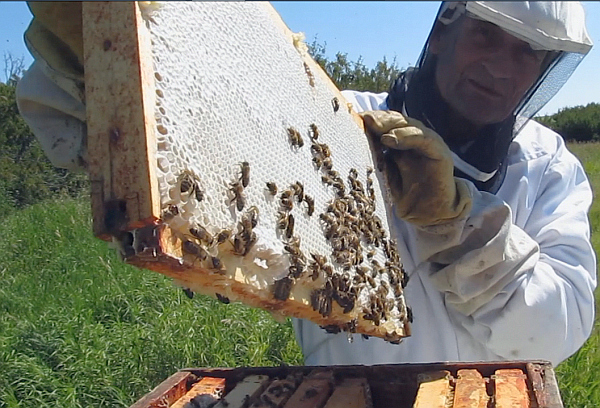 |
Not so much about bees and beekeeping in this entry... Except that this story relates a little bit to my old home town of Val Marie, Saskatchewan - the first place I ever owned a house and the place I grew a honey farm. I liked Val Marie and lived there for over ten years. My oldest two kids (Erika and David) were born in nearby Swift Current. Val Marie (obviously French for "Valley of Mary") was at first permanently settled by Québécois Canadiennes, around 1910. But settlers from other countries quickly moved into the arid badlands and farmed the rich black bottom land along the river. When I lived there (you can read my story in Bad Beekeeping), French was in fast decline as folks from England, Norway, Croatia, and Syria were settling the landscape. Yes, Syria.
One Syrian settler took some land up near Cadillac, north of Val Marie. The old homestead was pointed out to me in 1976 by one of the kids from the village - a chap who wanted me notice the variety of people living in south Saskatchewan's badlands. Nothing remarkable about the wind-swept farm. But something remarkable about the nine kids who grew up on that ranch. Habeeb Salloum spent his childhood on these prairies, helping his father farm their homestead - growing wheat, chickpeas, and lentils. The latter two crops were rare in Saskatchewan, but common in Syria - so this Syrian immigrant family contributed something special to Canada's economy. At age 21, Habeeb left Saskatchewan for the Canadian Air Force, serving until World War II ended. He eventually became a food critic and a prolific Toronto-based author. I just now noticed the publication of his 2010 book, Bison Delights: Middle Eastern Western Cookbook, which draws on his childhood experiences. It is apparently one of several books in which he merges his Saskatchewan and Syrian heritages to cook up some good reading - including 2005's Arab Cooking On A Saskatchewan Homestead.
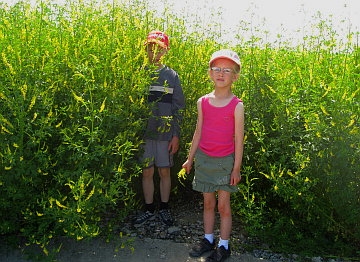 |
The honey flow has not quite started here in southern Alberta. But this picture, taken today at the farm in Milo, shows that the yellow sweet clover is obviously looking really good. We have had fantastic rainfall this year - probably double the norm - and the heat has started.
Yellow Sweet Clover may be the best honey plant in western North America. It grows prolifically in our alkaline earth. The books say it "prefers disturbed soil" which I think does not necessarily refer to the ground's mental disposition. We get plenty of disturbed behaviour after heavy rainfalls in the surrounding pastures and badlands - the water causes minor natural erosion - disturbing the soil and allowing seed germination. Sweet clover (both yellow and the white variety which flowers a couple weeks later) are biennials. The first year should be cool and wet all summer so the seedlings can get established. The second year requires a damp spring followed by a hot summer. It is during that second year that the plant yields tons of honey per acre. It's official name (Melitotus officinalis) includes the word 'melio' or honey. Two thousand years ago, the Greeks recognized it as a superb nectar plant. The honey itself is water-white and mild-flavoured.
With this year's excellent moisture and the warm days, we have great expectations for a fine honey crop. The bees could be better - they came through a rough winter and a cool wet spring which has kept colonies weaker than usual. But things are definitely looking better now.
 |
 |
We were at the annual fund raiser for ALS - two thousand attendees and much cash raised. It was especially gratifying for me because my wife, three-quarters of my kids, some family friends, and a great fellow-traveler (and ex-commercial beekeeper) were all with me on the circuit.
Many, many thanks to those of you who donated time and money to this cause. The ALS Society of Alberta, benefactor of the annual "Betty's Run", has received significant contributions over the years. This makes the lives of people suffering from motor neuron disorders (such as ALS or Lou Gehrig's) less isolated and less painful. No cures or treatments have yet been developed to cure the disorder. Basically, ALS (Amyotrophic lateral sclerosis) is a disease of unknown causes which kills 'motor neurons' - the nerve cells that carry messages from the brain to the arms, legs, throat, and lungs of a person's body. In fact, any movement - from blinking to wiggling toes - depends on healthy motor nerve cells. When these die, a person becomes paralyzed. When the lungs stop working, a person with ALS will die. So, this incurable disease is fatal.
The cause of ALS is still a mystery. I have been receiving interesting e-mails from a beekeeper in the Netherlands who is trying to solve this problem. Hans is quite certain that the cause of this illness (and many others) is "the toxic chemicals we breathe, eat, and drink." Hans has forwarded to me several scholarly papers published in the American Journal of Epidemiology (and other sources) indicating links between splicing defects in genes and the incidence of ALS. My Dutch contact's point is that pollution causes defects which in turn may cause motor neuron cells to die. This beekeeper has seen other beekeepers die from ALS... So have I - including a commercial beekeeper in British Columbia's Peace River and a hobby beekeeper here in Calgary, Alberta. From personal observation, the normal rate of ALS (one person in 30,000) is much lower than the rate of 3 beekeepers among the 300 or 400 whom I have personally met over the years. I wonder if others have similar observations?
So what might cause this significantly high incidence of motor neuron disease among beekeepers? Well, just because one percent of the beekeepers whom I know have this dreadful disease, that doesn't prove that beekeepers are more susceptible to ALS - my sample set is too small. Nevertheless. Perhaps it is not a coincidence due to a small set. According to Hans in Holland - and according to many others - it could be that beekeepers have the illness more frequently due to the beekeepers' extreme contact with bee-smoker smoke and maybe other environmental factors. I'm not so certain, as I would expect such smoke to also cause higher incidences of lung cancer - if the smoke is actually an issue at all. According to research conducted by the USA's National Institute of Health beekeepers actually have fewer cancer-related deaths than the general public.
Here is part of a summary text from NIH regarding cancer among beekeepers:
"subjects were identified through obituary notices published between 1949
and 1978 in three journals of the U.S. beekeeping industry.
Death certificates of beekeepers were examined for causes
of mortality, and proportionate mortality ratios were compared
with those for the general U.S. population. Beekeepers had a slightly
lower than expected fraction of deaths from cancer. The deficit of lung
cancers in male beekeepers was significant (p less than 0.05) and may
indicate that fewer beekeepers were cigarette smokers."
It is commonly believed that beekeepers are healthier than the general population. The physical activity and fresh air (especially when the bee-smoker is down-wind) surely play a role. Of course, it may be that beekeeping is more likely chosen as a career among people who like fresh air and exercise and tend to eat and sleep better than most other people. In this case, it would not necessarily follow that beekeeping creates healthy people - but instead healthy-lifestyle people select beekeeping. How does this figure into the ALS disease debate? I personally think it is simply coincidental that some of the people I know with this illness also have motor neuron disorders. If you saw my March 30, 2011 entry to this blog, you will have read that bee stings (an unavoidable bonus to beekeeping) may actually offer some defense against this disease.
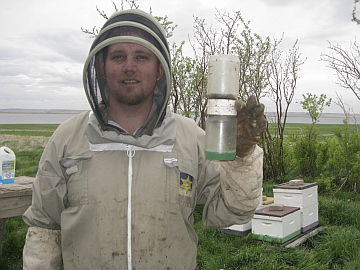 |
Varroa mites are ubiquitous in North America. Ever since they were accidentally imported into Canada back in 1985 by Saskatchewan's chief apiary inspector, they have been spotted in more and more apiaries. Now the varroa mites are as common as honey bees. If you are not familiar with the accidental Saskatchewan importation, you can read the full story in my book, Bad Beekeeping. But in brief: The chief inspector of bee diseases and pests in Saskatchewan was trying to conduct a test on the relatively harmless tracheal mite. So he imported about 30 packages with tracheal mites into Saskatchewan to study those minor pests. By the end of the second season, the entire experiment had to be scuttled when someone finally noticed that thousands of varroa mites were crawling around in those tracheal test hives. Big Oooops! They accidentally imported the wrong pest (a much more dangerous pest) and didn't notice for months and months. Oh well, a science experiment gone wrong...
So, now that Canada has varroa mites, what does that mean for beekeepers? Quite a lot, unfortunately. Unchecked, varroa destroys colonies. Dead. It takes about two years for a minor infestation to develop into a big infestation and to kill a colony. Some people hope that the mites will adapt to honey bees. After all, dead honey bees make poor hosts for bloodsucking mites. As it turns out, the varroa mite recently jumped from Apis cerana to our Apis mellifera so the mite hasn't yet had time to adapt to its new host. However, varroa has lived with Apis cerana for thousands of years, so they have adapted to each other. To speed up a symbiotic relationship, some beekeepers have advocated banning treatments against varroa mites. Eventually - possibly - the world's honey bees and varroa mites would learn to co-exist. This doesn't necessarily have to happen. Instead, all Apis mellifera in the world might simply die. Advocates of the "don't-medicate, decimate" philosophy are hoping that somewhere in the world there will be a surviving hive. In theory, its genetically homogenous mono-creature off-spring would be a mite-resistant stock that might re-populate the world. Perhaps.
Meanwhile, back in the real world, Justin is holding his mite-shaker contraption, examining samples from all our bee yards to see if we need to apply any treatments to counter varroa mites. Only those colonies with elevated mite counts are treated with formic acid, a relatively safe natural product that reduces mite numbers without doing much harm to anything else. We are using formic acid because it is commonly found in nature - commonly used in animal feed as an antibiotic replacement, the acid breaks down quickly after using it.
We sometimes forget that non-beekeepers are often big fans of honey bees. You don't need to "own" a dozen colonies of bees to become fascinated by the insects. I am intrigued that the museum in the town of Delta, British Columbia, has had a beekeeping display going this spring. Such presentations are probably possible at thousands of small museums around the world. These are usually free to exhibit but create thousands of dollars worth promotion for the bees. Delta Museum and Archives Society invited provincial apiarist Paul Van Westendorp to speak to the public and to introduce the new exhibit "Life of a Delta Bee". The display follows Beatrice ("Bea" as she is known to her friends) as she honeys around south coastal British Columbia.
The USDA places this winter's colony loss at 30%. In this release, the United States Department of Agriculture says winter losses continue at a rate far higher than the 5% which beekeepers typically accept as normal in the USA. Unfortunately, the 'acceptable' five percent loss is starting to look like long-gone historical memories. Beekeepers responding to the USDA survey said they would find losses of up to 13% as still 'economical'. One more interesting fact - about a third of the dead overwintered hives had no bee bodies in the hives - typically a symptom of Colony Collapse Disorder. Here is a chart of the USDA numbers:
| YEAR (winter season) | |
| 2010-2011 | |
| 2009-2010 | |
| 2008-2009 | |
| 2007-2008 | |
| 2006-2007 |
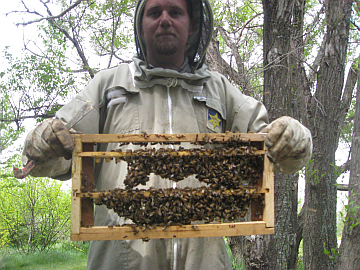 |
Alberta beekeepers sometimes raise queens. This photo, right, was taken at our Milo, Alberta, honey farm today. It shows Justin's first-ever queen graft. Sixty percent of his effort was rewarded by developing queen larvae. These new cells were started from select overwintered Alberta mother queens which somehow survived our dismal winter. Justin transferred larvae from the best of our over-wintered hives. This weakened these good hives a bit. But if done right, it can keep those strong hives from swarming while yielding some new hives to get colony count up.
Here are my super-simple queen-breeding suggestions for the timid:
1. Monitor your hives for a while. Select a couple really good hives - adapted to your climate and geography. These should include absence of disease, gentle disposition, massive honey production, and all the other traits you'd love to see in your own children.
2. Set up a single-storey starter hive in the spring - after you see drones running around in your hives. This must be a good hive made queenless and broodless by you and boosted with lots of extra young nurse bees.
3. Graft from your selected breeders, place the potential queens into the starter hive.
4. Next day, pull out the cells (similar to what you see in the picture here) and transfer them to a finisher hive. Your finisher should be a super-strong double storey, queen in the lower box below an excluder. Carefully set the cell rack between two frames of pollen in the middle of the crowded upper box.
5. A day before they are ready to hatch, transfer each cell into a split or nuc. The nuc should have at least three frames of bees, no queen, honey, pollen. Stagger the nuc boxes around a mating yard. Over the summer, these nucs have a chance to develop into hives with new queens - strong enough to survive winter.
There is much more you need to know. Dr Larry Connor has recently written a great book, Queen Rearing Essentials, which has a lot of how-to photographs. He adds much detail to the sketchy outline I've given you, above. And he offers alternative systems which are quite different than my suggestions in this blog entry. The book highlights the best family-owned queen breeding farm in North America, which is located in Florida. And owned by my brother David.
They say you can't go home again. Southern Saskatchewan was my home for over ten years. During the past few days, I have made one of my rare pilgrimages to the spot where I once produced the best honey in the world. The year was 1978, I was 24 - a new settler, single, alone. My nearest family lived 3000 kilometres away. I had no money, but was pretty determined to make beekeeping work in southern Saskatchewan. And it did, for a while. The summer of my 24th year, I produced almost two hundred thousand pounds of honey - extracting at night, rushing the empty supers back out to my 600 hives during the day. It was a year when the honey gods turned on the nectar for forty perfect days. Boxes filled with gorgeous white honey. I emptied them; the bees refilled them. Now, 33 years later, I've just returned back from a trip to the scene where I again viewed the hills of the badlands, the rich moist river valley. In three decades, I've found that many of my friends have moved on to a much quieter place - leaving the village I'd called home smaller, depleted. But the sun, soil, and flowers that made this area a beekeeper's paradise are still there. And, I have to agree - though you can't go home again, you can sometimes revisit old memories...
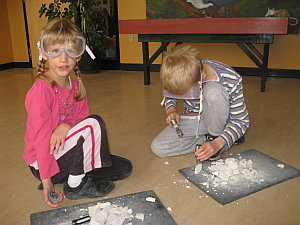 |
We are in Saskatchewan, on our last day of a beekeeper's sojourn. Somehow it seems fitting to spend this day at a dinosaur museum. According to Reverend Camping, an extremely vocal California preacher, today is Doomsday, the day of the rapture. (Although by the end of the day, Rev Harold Camping had rescheduled the event for October 21 - probably something to do with Gregorian vs Julian calendars.) Since our family is pre-selected as exempt from this great sweep-up into the sky, we figured we might as well be totally evil and hang out at Saskatchewan's phenomenal Eastend Dinosaurium. I don't mean to offend the people who sold their houses and sat on their suitcases today. Maybe they are right - perhaps the rapture occurred at 6 pm local time as predicted - but so few people were eligible that their disappearance went unnoticed by the rest of us. In the great Libertarian Tradition that I sometimes agree with, these folks are entitled to their private beliefs - as long as they don't use other people's tax money to promote their stories in schools, parks, or on the sides of aircraft carriers.
Although this was a road trip to seek out old friends from my Saskatchewan beekeeping days, we added the dinosaur museum mostly because it was just over the hill from the cottage we rented for two nights. The museum was built to house the bones of Scotty, one of the world's few fully articulated T-Rex skeletons, who was discovered in the south-Saskatchewan Eastend badlands in 1991. Rather than miscellaneous old bones assembled and glued together with scientific reason and deduction, Scotty only required dusting off to reveal his complete skeleton. It was a remarkable find - fossilized bones of a vicious creature who lived 67 million years ago (somewhat pre-dating Rev Camping's 13,023 year old universe).
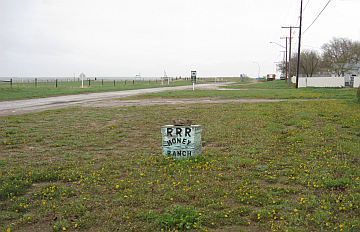 |
The Triple-R Honey Ranch in Val Marie, with fewer than 200 hives of bees, is the only remaining honey farm in the Frenchman River Valley. The farm shop and home are located on River Road, just three houses east of my old home place and shop. My honey farm in this town dissolved during the 80s droughts, many years ago.
The new Val Marie honey business (Triple-R Honey Ranch) is a relatively new start-up, operated by a carpenter. He is also a skilled and knowledgeable beekeeper with over fifteen years commercial beekeeping experience. I rapped on his door, hoping to buy a few pounds of world-famous Val Marie honey. But I did not get to meet him this day. The carpenter/beekeeper was working a few hundred kilometres away, earning the money he needed to keep his honey farm going. A lot of people don't realize that there is not much money in keeping bees. It looks like all fun and money - but operating costs are huge and if a beekeeper hits a poor year or two, there is no way to survive except by spending past savings, borrowing money, or working off-farm. Standing in today's cold misty rain, it was depressing to learn this beekeeper's holdings had slipped and he was operating fewer hives each year. I hope this spring's heavy rains will yield forests of alfalfa and sweet clover. I wish this man a bumper crop that will fill a thousand honey buckets.
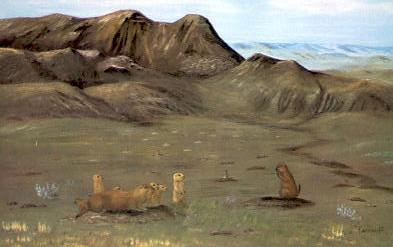 |
Val Marie was selected as headquarters for the Grasslands National Park in about 1985, when I still lived in the area. The park was created at the request of conservationists, which included local ranchers. One of those early rancher-advocates was Lise Perrault, who created the oil painting which I own and have reproduced here for you to see. A self-trained artist, she began painting in her later years (after raising nine kids and helping run a ten thousand acre cattle ranch). In the 80s, she and her husband created a museum in their basement. It was among their collection of rattlesnake skins, teepee stones, and pictures of the young NHL star Bryan Trottier and the cowboy-novelist-artist Will James that I learned a good deal more of the history and lore of this cowboy valley.
The Grassland Park is a desert environment with Canada's only prairie dogs and wild ferrets. Rattlesnakes, black widow spiders, and cacti add to the mystic. Part of the park has Canada's largest collection of dinosaur bones. Bobcats and lynx, antelope and coyotes. You can also see a wild herd of freely roaming bison, for which which the park's handy guide advises caution (especially if the animals begin "snorting, rolling or shaking their heads, or charging" at you - I suppose that last clue would definitely be your last clue).
The park now encompasses half a dozen of my old bee yards - but many more locations remain outside the bounds of this national park. It is remote, accessible only by a six or eight hour drive from cities with airports. There are a few services in the village, including a campground. Because of the remote location, I'm not sure I would recommend a visit unless you've got other plans in the area and unless you've developed a keen interest in Canada's prairies and grasslands. I mentioned Wallace Stegner yesterday. He was the Pulitzer winner who lived in this area a hundred years ago. His words reflect well on Canada's newest national park:
"Something will have gone out of us as a people if we ever
let the remaining wilderness be destroyed...
We simply need that wild country available to us,
even if we never do more than drive to its edge and look in."
- Wallace Stegner
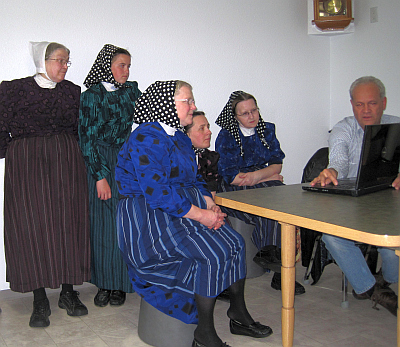 |
Among my friends in the Val Marie area are the people of the Sand Lake Hutterite Colony. I was in my twenties when I lived in Saskatchewan, and this religious order's followers fed and entertained me most Saturday evenings. It was great for me to drive the twenty minutes from my house in Val Marie and settle into a big bowl of chicken noodle soup, often followed by Germanic acapella hymns. These people took a huge interest in my well-being, but never tried to convince me to sell my possessions and move into their monastic life with them. It was enough that we shared bread.
On this trip, my wife and two small kids along, we had a wonderful lunch, then my fellow travelers were off for a tour of the kitchens and school. I stayed behind with my friend Annie, now past 80, and the widow of my great friend Reverend David. It was David Kleinsasser who eased my way into the colony's life, advocating for me and my bees' honey. David was a tireless emissary for my honey crop - it was he who eventually had Hutterite colonies throughout the US and Canada buying tens of thousands of pounds of my white, mild, Val Marie clover honey. By the time my wife and our kids returned from their tour of the classroom and library, Annie Kleinsasser had fully discussed life, aging, and death and we had both concluded - on this dark rainy afternoon - that life and death were a bit of a drag.
Not sure who the Hutterites are? These Germanic people have their roots in Switzerland and Austria and have their binding principle on a phrase from the Book of Acts which suggests that Christian folks must share property and not have individual possessions. Their original leader was a reformist priest - Jacob Hutter - who preached adult baptism, individual accountability, and the communal lifestyle - way back in 1620. He was, of course, duly burned at a stake by other priests for this heresy of thought. If you'd like to learn more about the Hutterites and their communal living, watch this video from Canada's National Film Board and you'll know almost everything.
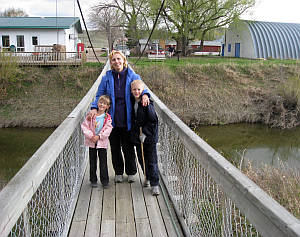 |
Eastend, Saskatchewan, was once the west-end of my Saskatchewan honey farm. I knew a few of the ranchers and the prairie ranger (head of the PFRA) who let me set bees in sheltered enclaves among the wolf willows here. About 200 hives amid 2000 acres of irrigated alfalfa and sweet clover. The bees did stunningly well here - but it was almost two hours in the old red Ford flat-bed from the shop in Val Marie. So it made little sense to drive so far, waste so much fuel, and produce just as much honey at the close-in yards. Eastend was redundant for my honey production efforts in the early '80s, so I moved those 200 colonies back to Val Marie, a hundred kilometres east along the Frenchman River Valley.
But Eastend holds a certain spell. Not that you would notice any siren song there today. The population has fallen by twenty percent in ten years. Closed stores. Abandoned houses. Quite a drop from the old days when future Pulitzer Prize winner Wallace Stegner lived here and later wrote about the place in Wolf Willow. Before that, the Royal Canadian Mounted Patrol built their "East End" police station (as opposed to their Calgary-area west end post) and a town of a thousand sprung up along the river valley near the police fort.
Around 1910, when alfalfa and sweet clover (non-indigenous, invasive species) spread through the valley, the place became a veritable Eden for the honey bee (also a non-indigenous, invasive species). In wet years, the hills around Eastend - and along the length of the Frenchman River - sparkle with droplets of nectar oozing from wild yellow sweet clover. Along irrigated patches next to the river, cattle ranchers cultivate alfalfa for hay - another tremendous source of nectar. In good years, Eastend honey bee colonies store three hundred pounds of water-white, extra-mild, low-moisture honey. In poor years, the frequent droughts desiccate the landscape, sere winds parch the patchy flowers which whither without benefit to starving beehives. I have seen both sights. This year - cool and very wet so far - should be a honey year. Unfortunately, there are few (if any) hives of bees in this part of the high prairie valley these days.
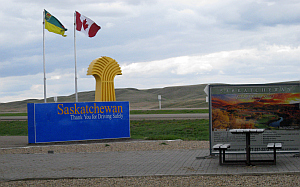 |
Saskatchewan is the big rectangular province that's easy to draw. But hard to spell. I have not traveled in Saskatchewan for a few years. This trip is long overdue. Long ago, I had spent many years in the province, so I convinced my family that a road trip on this long May weekend would be fun, interesting, educational. Already, the kids are getting good at drawing maps of Saskatchewan. But it is cool and rain is expected to be heavy for the next few days. Southern Saskatchewan farmers usually beg, plead, sometimes even pray for rain. This year, they have been asking for a respite as many fields are still unseeded due to soggy bottoms on the open prairies.
Until today, I not seen Saskatchewan's wild skies in five years. It was my home, the place I learned prairie beekeeping, produced a million pounds of honey, and eventually, at age 33, went to university. I was bringing my wife and our two small children on this trek from Calgary in order to rediscover prairie heritage and revisit friends and places I had known. I had arranged a couple of nights at a cottage in the badlands. Among our stops would be a colony of followers of Jacob Hutter, a sixteenth-century Anabaptist; a newish national park headquarters; and, a wheat farmer whose ancient meteoresque rocks were in a cardboard box in the back of the van. The latter had been in my possession for the past five years - they were gathered from the wheat fields of southern Saskatchewan because they looked much like valuable meteorites. But unfortunately for the farmer who owned them, the professors at the University of Calgary had determined otherwise.
 |
On the main drag 20 kilometres south of Calgary's lower end, you will see a warning sign. I pulled over to snap this photo. I was really happy to see that my friends at Chinook Honey had found still another way to promote the honey industry. Art and Cherie continue to amaze me with their enthusiasm for all things honey and for their bubbling energy. They started Chinook Honey in their front yard about a dozen years ago. They have since built a honey business, honey store, and now, a meadery. People who know a lot more than I do say their honey wine is the best in the country. I have been told that the best mead requires consistent, mild-flavoured, light-coloured, heavy-bodied honey as its sweet base. Alberta honey is all of these things, so I guess good wine - produced with good wine-making skills - naturally follows.
Should you someday find yourself in Alberta, you would do well to visit Chinook Honey. After viewing the glass-walled honey bee observation hive and after touring the meadery, you might buy some good honey and some great wine. If you've got a group, Art and Cherie offer honey making tours - both for adults and for kids. The price is pretty cheap, so the kids' tour is especially popular among school groups. These people have developed a lot of experience explaining bee culture (and wine-making in the adults' tours) so it is well worth the visit.
 |
Spring is almost here. It is May, after all. In this picture, you can see the remains of a massive snow bank which had completely buried this bee yard for a few months. We were nervous about the effect the snow cover would have on our colonies. Although the hives were sheltered under the snow, we didn't know whether they had enough honey for winter feed. Were they suffocating on their own carbon dioxide? Were they desperate needing a cleansing flight? What would we find?
This week, Justin unwrapped these hives and began the first spring inspection. Results were good. There is some variation from location to location, but over-all, the bees wintered well and look healthy. I think the fumagillin fed to the bees in the fall was essential to our good results. Penned inside for months, and buried under damp snow, these bees could have had nosema issues - but they did not. This photo is typical of this spring's survival - out of the 12 colonies in the picture, one has perished. Three are rather poor. Queens are present, but populations are pretty small. Those three may yet develop into productive hives this year, we'll know in a month. But the other eight look fine. To give them a boost, Justin swapped stand locations Meanwhile, tawny coloured pollen - mostly from crocus and various tree sources (especially willow) - is pouring into the hives. Justin scraped bottom boards, reversed the double stories (brood was mostly still upstairs, bottom boxes tended to be sparsely populated, and inspected the bees.
Spring has arrived late. Perhaps three weeks behind a normal year. Farmers are concerned - they haven't begun seeding; some years they are almost finished by now. It seemed the snow would never end. We are still hoping we can pull nucs for increase out of at least half the hives. Those would be the ones that would normally swarm if not aggressively handled. Our plan is to take three frames of bees and brood from the potential swarmers and put these into a single-storey box stocked with a bit of honey. Into that goes a queen cell which we will graft rather soon. This is a nuc, or divide. A few young drones are already wandering around in the better hives, so grafting could begin any time we feel hives are ready to split - and as soon as the weather stabilizes a bit! In preparation for grafting, today we set up a strong queenless single with a frame of pearl brood. The idea is to let this hive start raising some emergency queen cells from which we can harvest a bit of royal jelly for priming the grafting cells next week.
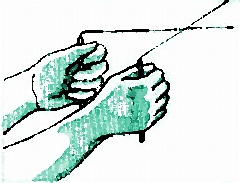 |
My day job as a geophysicist rarely collides with my other life - as a honey bee enthusiast. But today I received a nice letter from a friend. He has been reading a little beekeeping book about the effects of the earth's EM (electromagnetic) oscillations on a bee colony's health. The book's author (Mr John Harding) is claiming that the earth's normal resonant EM vibrations (tuned at a very low 7.8 Hz) is not naturally preferred by our buzzy friends. They reportedly like a higher frequency which also determines where swarms land and which will kill varroa mites in a few weeks. I haven't seen the book, but its thesis is apparently presented in a feverishly high-frequency tone itself.
Before losing my audience with maths and physics, let me throw some fun things at you, then I'll try to tie it all together. Vibrating Earth Waves. Nikola Tesla. Sunspots. Divining Rods. The International Oil Cartel. Colony Collapse Disorder. The Fantasyland Theme Park at the West Edmonton Mall. OK, have I got your attention? The Serbian-Croatian mad-scientist Nikola Tesla discovered a way of extracting some of the EM energy in which the earth's surface is encased. His goal was free energy for everyone. Tesla was awarded several patents for his impractical devices that would allow harnessing this energy. Unfortunately, the International Oil Cartel made him look looney so no one invested in his ideas, according to conspiracy theorists. Irregardless, this EM field permeates our souls and - according to some believers - influences our health and our attitudes. Here's how that works. This electromagnetic field vibrates at a fundamental frequency of 7.8 Hertz, but it is not stable. It is easily disrupted by sunspots and aquifers, among other things. Standing in the wrong spot can give you some bad vibes, apparently.
Back in 1952, the variations in this global electromagnetic resonance phenomenon was predicted mathematically by the physicist Winfried Otto Schumann. (You can look up "Schumann Resonance" if really need to know the maths.) Schumann found that the EM guide waves which resonate between the earth surface and the ionosphere are normally tuned to 7.8 Hz, but peaks also commonly occur at 14, 20, 33, up to 60 Hz. What the heck am I talking about - EM waves and Hertz? EM waves are light, radiation, and radio signals. Hertz is the number of crests of these universal ocean of energy waves passing under your toes each second. For example, with blue light, for which our eyes act as receivers, the frequency in Hertz is 750 million! So, the energy we are talking about has wavelengths a hundred million times longer. But it is still formidable, powerful energy - like a tsunami (which also has low frequency waves). Some people claim that since we are used to living in this sea of long, powerful waves, we are badly effected in areas where this field is distorted. Although my geophysics studies never involved mapping these perturbations, it is claimed by some (non-scientist) folks that "Divining Rods" find water by inadvertently locating high frequency EM wave locations.
Hang on to your smokers, this all ties into beekeeping. According to Harding's book, which he claims is based on his work with 300 hives of bees, honey bees prefer to swarm to the same places where this earth vibration is around 250 Hz - outside Schumann's range, actually, but equal to what Harding calls the "bees natural vibration". He also says that if an apiary is established on Electromagnetic Geopathic Stress Lines (as Harding calls high-frequency locations), mites will die and bees will thrive. I'm not sure how he can convincingly claim these "Stress Lines" are healthy for bees, but deadly for mites - and cause divorces and cancers in people, but he has convinced himself. You can test the theory by placing your hives in spots where the dowsing rods cross (or you might drill a well there). And, if you find a swarm, test the spot with the rods. It would be interesting to know if the swarms statistically prefer those rare locations where the wires cross. If you want to know more, the book's author (John Harding) has contributed some long comment entries to various talk and blog pages. You can find one near the bottom of News Cafe's page and another at this blog. Read the author's opinions and fiery presentation yourself. But the connection between the frequency of electromagnetic waves and the physical vibration of a honey bee body is not scientifically explained nor empirically verified. Most of this - in my opinion - is a bit whacky. But then, so were many of Nikola Tesla's ideas.
 |
Optimism. That's headline news coming from beekeepers, isn't it? But that's the way this Edmonton, Alberta, beekeeping story is written. Heavy on optimism! Gotta like that! Beekeepers can be a gloomy, dour lot. So it is refreshing to hear them talk about high honey prices, good wintering, healthy bees. Colony counts are up across the province. The heavy, heavy, heavy snowfall over the past six months has planted moisture into the landscape. It should be a nectar-drenched summer. Get ready for a bumper crop. Alberta has forty per cent of Canada's honey bees, so our success here will be positive for agriculture and for exports. Part of this healthier, happier forecast is attributed to recognition of the problems Nosema cerenae (a bee-gut disease) was causing and the remedial efforts of beekeepers to get that ailment under control. Rates of nosema are down and bee populations are up.
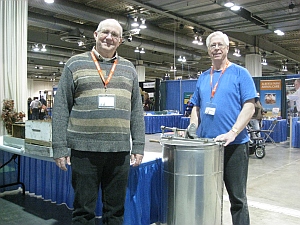 |
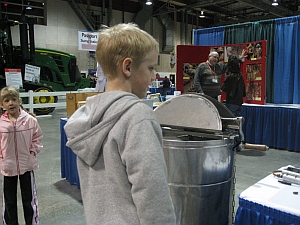 |
Calgary's Aggie Days has been happening in our home town since Friday. We brought the kids over to the Stampede Grounds to see the baby chicks, spitting llamas, and hollow plastic cows. (So, that's where milk comes from!) But, of course, the highlight of this farm expo is the Calgary Beekeepers' beekeeping exhibit.
Volunteers from the club take the time each year to set up a display of beekeeping equipment and honey. These folks spend hours describing bees, beekeeping, honey, and pollination to visitors. The event draws tens of thousands - mostly school groups and families with small kids. Entry to the entire grounds is almost free. Our sincere thanks to the dozen volunteers who made this year's event successful!
California beekeepers are irritated that they will be taxed for honey bee research. The proposal to collect one dollar per hive from every beekeeper (with more than 50 colonies) doing business in California has Stirred Up a Swarm among beekeepers. It is argued that beekeepers are having a tough time as it is, so they can't afford this tax. Though beekeepers almost universally agree that the research into honey bee health is vitally important, they also agree that they shouldn't pay for the research themselves. So who should pay? I guess the general public, which benefits from bees as much as it benefits from roads, schools, and police. But (shhh!) don't let the Tea Baggers hear about this. They would rather see beekeepers pay the bill for bee research themselves and quit abusing the public coffers. As one Tea Bagged fellow told me, "You beekeepers are always getting handouts from the government. That's got to stop. Now!" OK, we hear you. But what will you eat, my friend?
In an unrelated story from the Associated Press, we learn that "Bees in South Dakota to get Government Handouts". Well, we happen to think some restrictions should apply: The bees may not spend the cash on smoker fuel or fermented sugar syrup. And the money must be spent only on stuff made in the USA. (That should keep the Tea Baggers happy.)
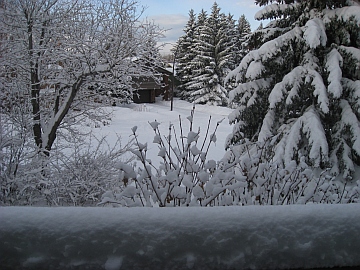 |
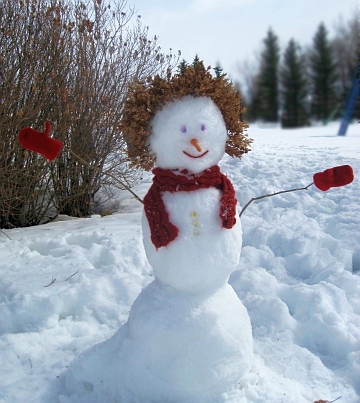 |
April, and the epic snowfall continues!. We've never seen so much snow here. Most of our hive locations are inaccessible. Some hives are buried under a meter of snow. These have not seen sunlight in three months. Experts I have spoken with are divided about the best course of action. Some have advised us to dig the bees out. I'm not sure. Can bees get oxygen, even in hives that are totally covered by deep snow? Or does carbon dioxide build up, suffocating them? I'm not worried so much about the lack of light, though I know that with lengthening days, it is normal for the queens to get active and begin brood rearing.
Here in southern Alberta, some of the big commercial operators successfully winter thousands of hives warehoused in dark ventilated sheds. So, the lack of a lengthening circadian cycle is perhaps not such a big concern. We have a couple of apiaries that are fully exposed to the howling winter winds. These locations allow the bees cleansing flights on mild winter days, but I think the snow cover (protecting the bees from wild temperature variations and gale-force blizzards) is the better situation.
But I am speculating about something I don't know well. I have been here 35 years - this is the first winter I've seen on the southern Canadian prairies where entire bee yards have been enveloped with snow for months. Highly aberrational. In a few weeks, I'll let you know if the bees survived.
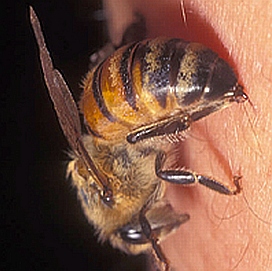 |
Oh, happy birthday to me. And to Dr Phillip Terc, who would be nearly 200 years old today and therefore a bit older than I. March 30th is Dr Terc's birthday - and also World Apitherapy Day because Dr. Terc was the first to scientifically study the medical uses of bee venom. Most people - beekeepers included - try to avoid the nasty end of the honey bee. But the sting may also be a therapy for some afflicted with a variety of disorders. Contrary to Shakespeare ( "Death where is thy sting?"), for many it is in life that there is the sting. Rheumatoid arthritis, multiple sclerosis, fatigue syndromes, chronic migraines, and asthma have all been purportedly cured or mitigated by bee venom.
Do bee stings really help? Mounting evidence suggests that it does. I don't know and I'm not an active advocate of apitherapy. There is a risk of allergic reactions to the stings. Less severe downsides include the simple fact that it is a painful therapy that might be expensive and might not work. Each individual, of course, has to weigh these factors against the possibility that their illness may improve. Or at least symptoms may lessen. Anecdotal evidence suggests that the improvement may be considerable and almost immediate.
How does it work? Bee venom has a huge number and variety of peptides, proteins, minerals, and molecules that could be at work. Phosphorous, copper, magnesium and calcium have all been identified. So have formic acid and hydrochloric acid. And histamine. But the main component is melittin, known for its powerful anti-inflammatory action. Also present are: adolapine (a stronger analgesic than opium); apamine (which offers restorative effects on the nervous system); and, cardiopeptide (known to stabilize the cardiovascular system).
A Dutch reader of this blog, upon learning that I have some peculiar varietal of ALS (motor neuron disorder) sent me a report on the effects of bee venom extending the lives of people with ALS. ALS - also know as Lou Gehrig's disease - is a an incurable, fatal, disorder in which a person's motor nerve cells die. These are the nerves that control walking, talking, breathing. ALS does not effect the brain - thinking and memory are completely normal. But when the motor nerves have died, the person with ALS can no longer move - paralysis is complete. Most people with ALS die of suffocation within a couple of years - the lungs have stopped working. About one in 300 people will get ALS, so a cure is desperately sought. Researchers in China have published their findings in the Journal of Neuroinflammation in 2010. The article, "Bee venom attenuates neuroinflammatory events and extends survival in amyotrophic lateral sclerosis models", was written by Eun Jin Yang et.al., who studied mice with ALS and injected bee venom to see if that would prolong survival. The conclusion of the study states: Interestingly, treatment of BV in symptomatic ALS animals improved motor activity and the median survival of the BV-treated group (139 ± 3.5 days) was 18% greater than control group (117 ± 3.1 days). Conclusion: From these findings, our research suggests BV could be a potential therapeutic agent for antineuroinflammatory effects in an animal model of ALS. I know two beekeepers who, in the past five years, have passed away because of ALS. In light of the research cited above, one might be tempted to question these scientists' conclusion. ALS is rare - if bee stings offered protection, what went wrong? Well, the research does not claim that bee venom is a preventative agent nor a cure. We might - from the research report - conclude instead that these people and others may have had a longer, healthier life because they were beekeepers. It would be very satisfying if the humble honey bee played a role in treatments for ALS.
Shakespeare again, from The Tragedy of Locrine...
"Let come what will,
I mean to bear it out,
And either live with glorious victory,
Or die with fame renown'd for chivalry:
He is not worthy of the honey-comb,
Who shuns the hives because the bees have stings.”
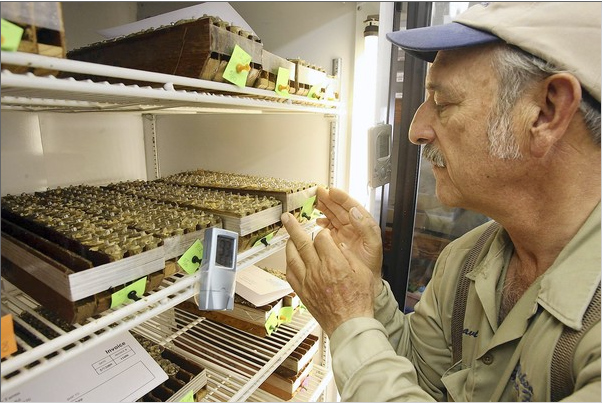 |
Last week, the Orland Sentinel ran a great beekeeping feature story about my brother David's queen breeding business near Groveland, Florida. (You may want to read the complete article here.) When the reporter phoned and interviewed me, I asked permission to reprint the story and include their photo in this blog. The reporter, of course, was happy to oblige. So here is most of the article:
Miksa, 66, breeds queen bees. He is one of about 50 specialists who are maintaining the endangered bee population by providing thoroughbred royalty to raise colonies. Though there are other insects that pollinate, honeybees are the easiest to manage for the large-scale pollination U.S. agriculture requires. In California, the almond crop alone uses 1.3 million colonies of bees, about half of all honeybees in the United States.
In the '70s, Miksa began buying property in Lake County. He found a niche off Groveland's Empire Church Road with plenty of citrus trees and plants perfect for maintaining hives. Today his Miksa Honey Farm is on about 40 acres, with the queen breeding and honey processing mostly off Honeycomb Road.
Miksa's dedication and success have brought a slew of international bee experts to his enclave. And Miksa has no intention of slowing down.
He will turn 67 in July, the same month 50 years ago that he began his research, says Miksa. "And I am still not planning to go onto the Social Security program, working 70 hours per week."
February 21, 2011
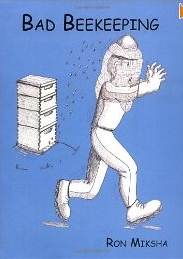 |
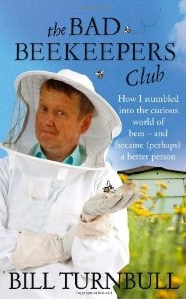 |
Oh my. Oh my. I just read Kim Flottum's Bee Culture review of Bill Turnbull's book, "The Bad Beekeepers Club" and I am still irritated that Mr Turnbull chose to name his 2010 book almost identically to my 2004 book (Bad Beekeeping). So, I am reprinting my knee-jerk reaction that I first published on these pages back in June, last year. If you happen to meet Bill Turnbull when this BBC celebrity is wandering around at his book signings, please ask him if he enjoyed my book. He hasn't answered me yet, though I left comments on his Facebook page begging him to send me a note. Alas, he must be as busy as a bee in thick honey. Or something.
Anyway, here follows my blog from June 2010:
Bad Beekeeping. I've been alerted - by unnamed sources - that my title as the world's consummate Bad Beekeeper may be threatened. This could collapse my entire Bad Beekeeping empire. At risk are my book (Bad Beekeeping); those Bad Beekeeping T-shirts I was designing; my Bad Beekeeping website; and even this Bad Beekeeper's Bad Beekeeping web blog - all are threatened!
The new boy on the block is a certain Mr Bill Turnbull (not to be mistaken for Mr Bill Turnbull, beekeeper and former Toronto resident). This particular Mr Bill Turnbull is of a country variously called Britain, the United Kingdom, and sometimes even England. Mr Bill Turnbull, a self-described Bad Beekeeper, has just written a fine book, which he calls The Bad Beekeepers Club, published in May 2010 - and (my sources say) Bill has begun to call himself 'the Bad Beekeeper'. Hey, isn't that my moniker? Can't he get his own cognomen? Bad Beekeeper - King of Bad Beekeeping - is what all my friends have called me for years. So, I am concerned. Surely Bill Turnbull - a popular TV personality in London and probably other places - knew he was giving his book a title perilously close to my (more accurately) titled popular book, Bad Beekeeping. (Which was published in 2004, by the way!) Unless he is a truly dreadfully and unforgivably bad beekeeper, then Bill certainly encountered my book during his research for his book. Perchance he encountered my memoir and subconsciously (or even unconsciously) thought "What a delightful title for a memoir!"
 I guess this hurts about the same way as when a Norwegian rock band (in the picture, to your right) ran off with my last name. It's true.
The metal band Miksha - according to an early version of their website - was apparently
so desperate for a great-sounding name that they called themselves
Miksha in honour of the "beekeeper military-genius who used
bee-derived poisons in Vietnam and then wrote about it in Bad Beekeeping." Of course not all of their story about me (Miksha) is true.
At first I was a bit miffed at their
theft of my name. Then I noticed a neat thing. As tattooed and pierced Norwegian metallic-rock enthusiasts searched the web for Miksha music, they discovered my
book and spent their twenty-five bucks on my memoir instead. Maybe by accident, but a sale's a sale. I saw a nice marketing uptick. Maybe the same will happen as
folks try to buy Bill Turnbull's Bad Beekeeper Club book.
I guess this hurts about the same way as when a Norwegian rock band (in the picture, to your right) ran off with my last name. It's true.
The metal band Miksha - according to an early version of their website - was apparently
so desperate for a great-sounding name that they called themselves
Miksha in honour of the "beekeeper military-genius who used
bee-derived poisons in Vietnam and then wrote about it in Bad Beekeeping." Of course not all of their story about me (Miksha) is true.
At first I was a bit miffed at their
theft of my name. Then I noticed a neat thing. As tattooed and pierced Norwegian metallic-rock enthusiasts searched the web for Miksha music, they discovered my
book and spent their twenty-five bucks on my memoir instead. Maybe by accident, but a sale's a sale. I saw a nice marketing uptick. Maybe the same will happen as
folks try to buy Bill Turnbull's Bad Beekeeper Club book.
Which book should you buy? Bad Beekeeping or The Bad Beekeepers Club? Should you purchase Turnbull's memoir, described by Little, Brown Books as a "charming account of how he stumbled into the mysterious world of beekeeping" or should you buy my book? Bill, again quoting the Little, Brown Books press release "was stung twice on the head". I've had a few more than that, so my cognitive function is likely even more impaired. And Bill (from the UK) is probably descended of a family that has at least some members who commanded the English language for twenty generations; I am a first-generation English-mother-tonguer. Hey, my people are still struggling with the grammar! (For example, Bill's book is called The Bad Beekeepers Club - I would have mistakenly placed an apostrophe after Beekeepers, rather than omitting it.) Point is, my guess is that Bill Turnbull has the better book, complete with superior grammar. But you should be the judge of that. Therefore, may I suggest you buy both of our books and make your own decision?
By the way, I haven't yet read Bill's book, but I certainly will. Maybe I am mentioned as the world's leading Bad Beekeeper and all will be forgiven. (By the way, Bill, if you are reading this - my latest book is called Bees Eat Money... I'd also like to claim title to Bees Eat More Money, The Bees Eat Money Club, and a variety of permutations. Just in case you're thinking of your sequel, too.)
 |
This shampoo tastes more like shampoo than honey. Lucky for me it was only bubbling in my green tea, not drenching my cooked breakfast oats. The hotel parked the stuff next to the bathtub, alongside a similar bottle marked SOAP, so I should have known better. But I thought truth-in-labeling laws were supposed to protect us from our stupidity. Obviously this product represents a severe breakdown in the powers of the nanny-state.
What is the law? Can 'health products' that may (or might not) contain honey make such good use of the word? In this particular case, no ingredients were listed - except the super-sized label saying honey and and the smaller font word 'shampoo' on the bottle. Does 'Honey Shampoo' need to have honey in it - if so, how much? How many droplets per bottle allows the manufacturer to prominently display its star component?
 |
"Yepperee, there blows one of them there Alberta Clippers," said the Fox Channel's weather report. Or something like that. I don't mind our province catching blame for frozen peaches in Texas - as they say, any publicity is better than no publicity. However, this map has labeled something which Fox calls an Alberta Clipper, but as anyone who has studied Grade 7 Geography can tell you, this storm clearly originates in Saskatchewan. (Doesn't Fox have anyone who can read a map?) This horrible storm should have been labeled as a "Saskatchewan Screamer" not an "Alberta Clipper" - why can't news agencies get their facts right?
It's a pretty sad state of affairs when Americans can't distinguish Saskatchewan Screamers from Alberta Clippers. But at least over fifty percent of Americans realize that the Canadian capital city, Toronto, is located on the west coast where a new igloo now houses Canada's Congressmen. (Oh back off - I'm just kidding. I've met plenty of Canadians who confuse Florida with California. Ignorance is internationally common.)
Thinking of keeping bees this summer? Well, you will need bees and equipment, of course. You will need to learn a lot about bees. And, in quite a few places, you'll need to become a criminal. It appears that about a hundred cities and counties in the USA have declared beekeeping illegal. Wild bees, hornets, and wasps are exempt. They can carry on as they always have. But bees housed in hives are apparently an issue in towns like Dayton, Ohio and Eau Claire, Wisconsin - two places which ironically figure strongly into the American heritage of beekeeping and beekeepers. Outside the USA, beekeeping is banned in many parts of Ontario, a few places in British Columbia, and even in West Sydney, Australia. A list of no-no places has been published on a Wall of Shame. Most municipalities, however, see beekeeping as similar to a lot of other private activities. You only get into trouble if you cause someone else grief - then the 'nuisance' ordinances usually kick in. Seems like a more sensible route than blanket-banning of a useful helpful pursuit.
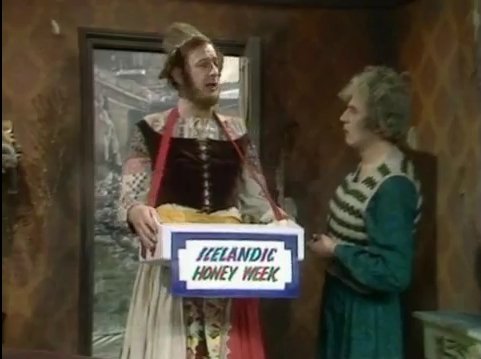 |
Iceland makes no honey? Actually it does, but according to Eric Idle, Terry Jones, and Graham Chapman (The Monty Python Flying Circus) it does not. This Monty Python skit declares, "No honey in Iceland. Well, that's a bungle, as Bureaucracy has decreed that there should be an Icelandic Honey Week. Alas, if only all bureaucratic flob-ups would be so enlightened. Here's part of the text, you can view the video here.
"In Reykjavik it is dark for eight months of the year, and it's cold enough to freeze your wrists off and there's only golly fish to eat. Administrative errors are bound to occur in enormous quantities. Look at this - it's all a mistake. It's a real pain in the sphincter! Icelandic Honey Week? My Life!"
If Monty Python has convinced you that Iceland is a honey-free zone, this arcticle from American Bee Journal nearly sets the confusing story straight. There are actually a couple of very persistent Icelandic beekeepers who have spent tens of thousands of dollars trying to get a hive or two to survive the long cold winters and the cool mild summers.
The article tells us that within 12 months of establishment, all the imported bees had died. Ditto the next year. A dramatic test in 2000 with 30 Norwegian colonies ferried into Reykjavik resulted in 29 dead hives within a year. Today there are a few beekeepers (maybe 10?), mostly around the capital - and a total bee population of fewer than fifty colonies. So far, it has been quite a struggle and proves that the truth usually doesn't stray far from Monty Python's reality. Never has.
I read a blog today about an American who has worked as a professional translator in South America for years. He is pretty irritated that machines are being used for translating journals and documents from one language to another. Part of the irritation is concern for the quality of the results and the esteem of the craft. He rightly points out that translating is an art that must account for nuances of expression and intention, not just simple linear word replacement. I remember when I was six, I learned the Greek alphabet, then took English words and substituted the letters one at a time. I thought I was writing in Greek and couldn't be convinced that someone in Athens would have no idea what I'd written. This is similar to chemists making 'honey' in the lab - they can create an almost convincing substitute by blending sucrose, glucose, fructose, and bits of pollen and bees' knees. But almost anyone can tell the product isn't honey. (And thankfully, there are laws against selling such a concoction as 'honey'.)
The same South American language blogger goes on to explain that the art of translation is much like the art of writing original materials - choice of word, appreciation for audience, style, colour, flavour are all important. With disdain, he cites a prolific 'author' who uses computers and technologists to scan the internet for publicly available data which he packages into 'books on demand' - this means you can order one of his books, his machines will scour references on-line, assemble the materials, then bind it between covers. In this way, Phillip M. Parker claims he has published 200,000 books - making him the world's most prolific author. Unwittingly, I had purchased one of his books about a year ago. I saw an inexpensive paperback called Beekeeping: Webster's Timeline History advertised on the internet. After it arrived in the mail, I was disappointed. I thought it would include opinions and insights regarding the relative importance of different discoveries. But it was basically a long list of dates paired with bee-related events. No weighing of significance. So, things like the discovery of how queens mate, Langstroth's book, the invention of the extractor, and Miksha's Bad Beekeeping book are all listed and (according to Parker's poorly prepared compendium) seem to be equally important 'events' in beekeeping's historical time-line.
 |
The Mythbusters busts a bee myth. Can a thousand honey bees, pasted on to a laptop, fly off with the computer they're glued to? I hope not. But a YouTube viral video shows that a single frame of bees, shaken onto a Thinkpad, can indeed lift it and fly away with the machine. Well, (spoiler alert!) they didn't really do it. The fake video uses wires and an off-camera crane to give the effect. The TV show, Mythbusters, does a nice job of applying science and logic to debunk this trick.
Mythbusters is my 8-year-old's favourite TV show; and it is the only 'reality-genre' program we tolerate in our house. What we tolerate about this show is that it encourages scientific testing and the debunking of popular notions. In this case, the testing team began by simply trying to replicate - as an experiment - what they saw on the fake video. First, The Mythbuster's Crew had to find honey bees. This meant they had to find a beekeeper. The Marshall family at Marshall's Honey Farm in American Canyon, California, were the accomodating keepers who let the TV crew bring in their lights, cameras, and some action. (One of the cast was apparently afraid of honey bees, but the show nicely portrayed him becoming more and more comfortable around the bees - finally telling the audience that these were pretty cool creatures.) At Marshall's Honey Farm, the crew smeared a "bee-friendly" glue mixed with honey on the closed cover of a laptop computer. They shook 3 frames of bees onto the cover. The bees stuck, but didn't fly away with the computer. With a scale, the crew found that the laptop was heavier, not lighter, though the bees were trying to fly.
Why couldn't Mythbusters get the laptop to fly? It would be logical to assume that the bees weren't strong enough. But to know this for sure, the team had to determine the lift capacity of a bee. They chilled a honey bee in a fridge so it would be docile while they looped a thread around the bee. (That's what the photo here is showing you.) When the bee warmed up, she lifted off with the thread which had weights on it - the team roughly calculated that the bee could lift 81% of its weight in this one-off experiment. That translates into about 96 milligrams. So, it would take 23,000 bees to lift the light-weight (2216 gram) computer.
How many bees can dance on the head of a laptop? They tried to figure out if 23,000 honey bees could actually fit on the lid of a closed laptop. They can't. The fellows used a wire grid, positioned over the glass side of an observation hive, and counted the number of bees in a square inch. (About 10. I told you this was a pretty good TV show.) So, the surface of a laptop (234 sq inches) could hold around 2000 tightly-spaced honey bees. This would generate only ten percent of the required lift.
After disproving the viral video, these aspiring scientists retreated to the laboratory to explain why the whole concept is impossible. Think about it: As the bees whirl their wings, they exert downward pressure - either on the air around them or on a fixed surface from which they are taking off. But if they are attached to that surface, it becomes 'heavier' from the downward force of the wind their wings are making. The more thrust the bees create, the stronger the resistance. (Imagine your bee-truck is stuck in the sand. You hitch a chain to the front bumper, wrap the chain's midpoint around a pulley, then hitch the free end of the chain to your back bumper. No matter how much gas you give it, you're not going anywhere.) As I said, we don't watch much television here, but this show is definitely a good program. At least this episode was. If you missed the show, you can find it here.
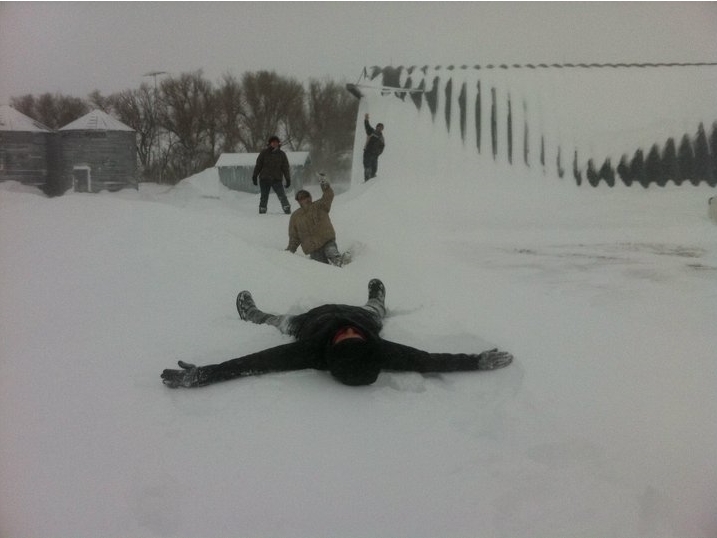 |
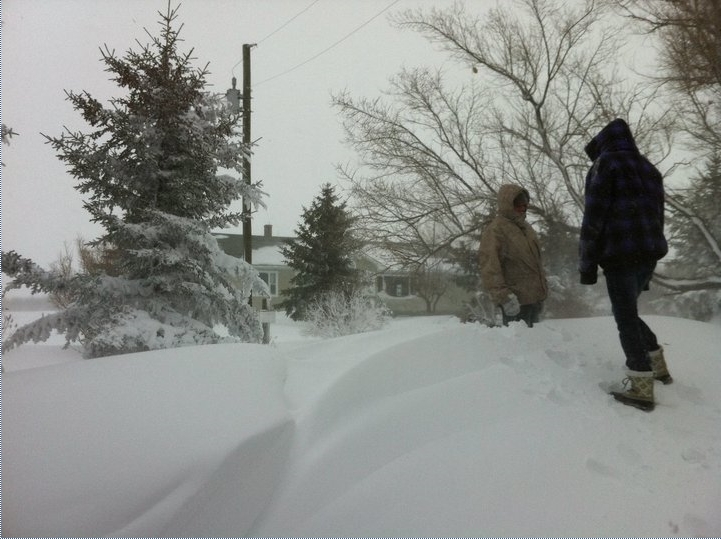 |
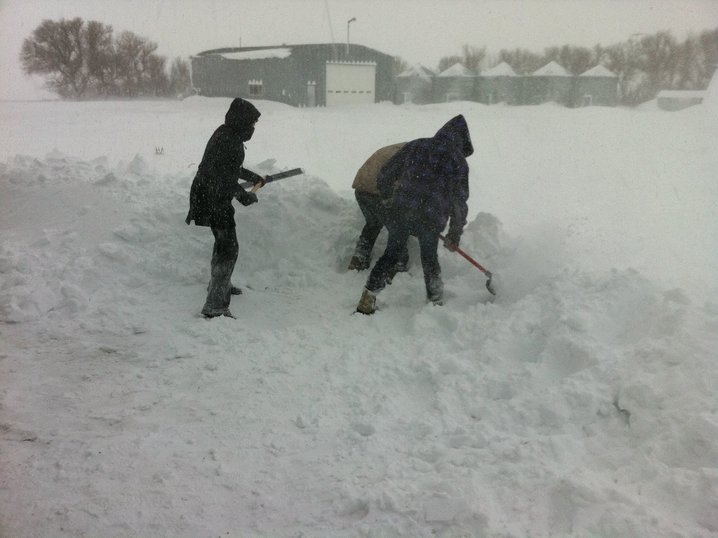 |
Snow Days at the Farm. We might be witnessing a record amount of snow at our Milo, Alberta farm. Drifts of over 2 metres (seven feet) blocked the driveway, and shrouded the house and honey shops. Luckily, Justin and Erika had house guests for the weekend. So, when they and their friends woke on Sunday morning, it was pancakes and shovels all around. It took the whole day to dig a path from quonset-garage to grid-road. Lucky me, I'm a hundred kilometres away in the city. So I could only cheer them on by phone. They did have help of sorts from an 'Old Clunker' - not me, but our farm tractor. Similar in temperament to me, though - it rarely ventures out in cold weather, has trouble starting, might stall unexpectedly, and maintains a cold heart.
What does a million kilograms of snow mean to us? It's like pennies from the sky. During some winters, our western prairies are bitterly cold bastions of blizzards - but may nevertheless remain desert-dry for months. When I moved out here 35 years ago, I was surprised that deserts can be bitterly cold. Southern Alberta gets less moisture a year than Arizona's Sonora. (But it looks much greener because so much of the year is cold and evaporation is much less.) It is not uncommon to have a cold winter with almost no snow in Vulcan County. Dangerous years for farmers follow such barren months. Without the snow barrier protecting the soil, winter winds can move a lot of dirt and will desiccate the soil so that spring is barely green, summer is brown, autumn yellow. At least these heavy wet snows are now giving us the hope and promise of a fair start for the new season.
What does this snow mean to the bees? It's a good thing. Hives buried in snow have a better chance of survival here than exposed colonies. Though they won't get the occasional respite - a winter cleansing flight - until the snow melts below the level of their upper entrances, they will, however, be snug and warm. Most of the larger operators in southern Alberta winter their hives inside huge steel warehouses. Those bees have even fewer winter cleansing flights. So, the hunch is that healthy bees can take the long confinement.
Hobby beekeepers frequently ask me if they should dig their hives out of drifts. I usually say, "Don't." But everything in beekeeping depends on local conditions. Those conditions include hive size and shape, type of honey stored for winter feed, climate, and a bunch of other factors. Always keep this in mind when you read about beekeeping on the internet. We are keeping bees in Alberta, Canada. Recent web readers have been from South Africa, Sweden, and Slovenia. Whatever I write here is basically entertainment and perhaps a source of voyeuristic eaves' dropping. Maybe some useful information - but it is up to you to try to distill that, adapt it, and use it where you can.
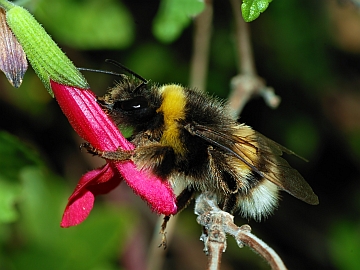 |
Bumblebees are in the news a bit. It seems they are facing numerous modern perils, similar to our honey bees. If you are not sure whether the bees you are keeping are honey bees or bumblebees, watch how they handle a football. Bumblebees, sometimes called Fumblebees, are noticeably less agile on the pitch. They are also generally fatter, fuzzier, and (according to primitive 19th-century science) unable to fly. Not content to simply observe the obvious, zoology scientists at Oxford were able to model the bumblebee's height/weight/wingspan and determine that the bumblebee does indeed fly (not hop or crawl) from flower to flower.
Well, the bumblebee's hop, skip, and jump are seriously in peril, if the science conducted by University of Illinois entomology professor Sydney Cameron is accurate. According to a CBC report, Dr Cameron used historical records from the late 1800s and "found the relative abundance — the proportion of the studied species out of all bumblebees — of four species decreased by up to 96 per cent since that period, and their geographic range contracted by between 23 and 87 per cent." That's an astonishing fumble in bumble numbers. At least a part of the die-off is due to a type of nosema - similar to one of the illnesses plaguing the honey bee.
By the way, this stunning photograph (right) is from Wikipedia's Media Commons and is a Bombus terrestis. The picture was taken by Alvesgaspar with a Nikon D80. Copyright permissions are under the Attribution-Share-Alike license.
Oh. And how does the bumblebee stay afloat? According to the common folk tale, the bee is too heavy for its wings and should never take off. The short answer is that the bumblebee uses brute force, similar to the way beekeepers stay in business despite their profit-loss statements. Let's hear it for brute force and its ability to defy nature!
New Year. Here we go again. I am back in Canada. Yesterday, it was Hungary. No telling where I'll end up tomorrow.
By readers' demands, I have reluctantly begun to publish this blog in "reverse" order - which of course is actually the "natural" order for an on-line blog. People tell me that this is what is expected. And it makes it much easier for readers to find the latest entry. My earlier objection had been simply that (in my old-fashioned opinion) people like to read chronologies in chronological order. And relating a beekeeper's year is certainly a chronological exercise. Meanwhile, you can find my older, orderly blogs elsewhere on the net: 2008 Blog; 2009 Blog; 2010 Blog.
